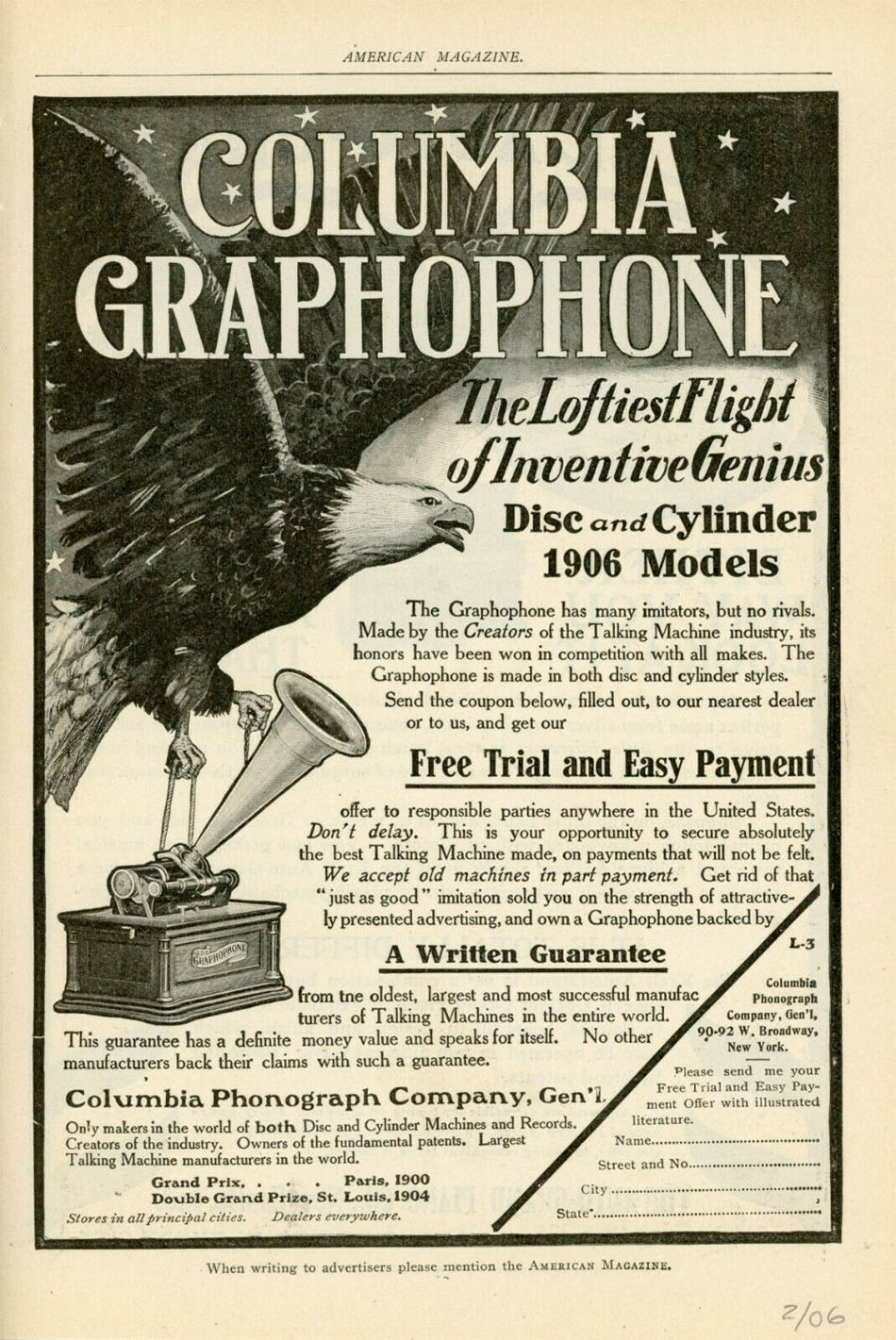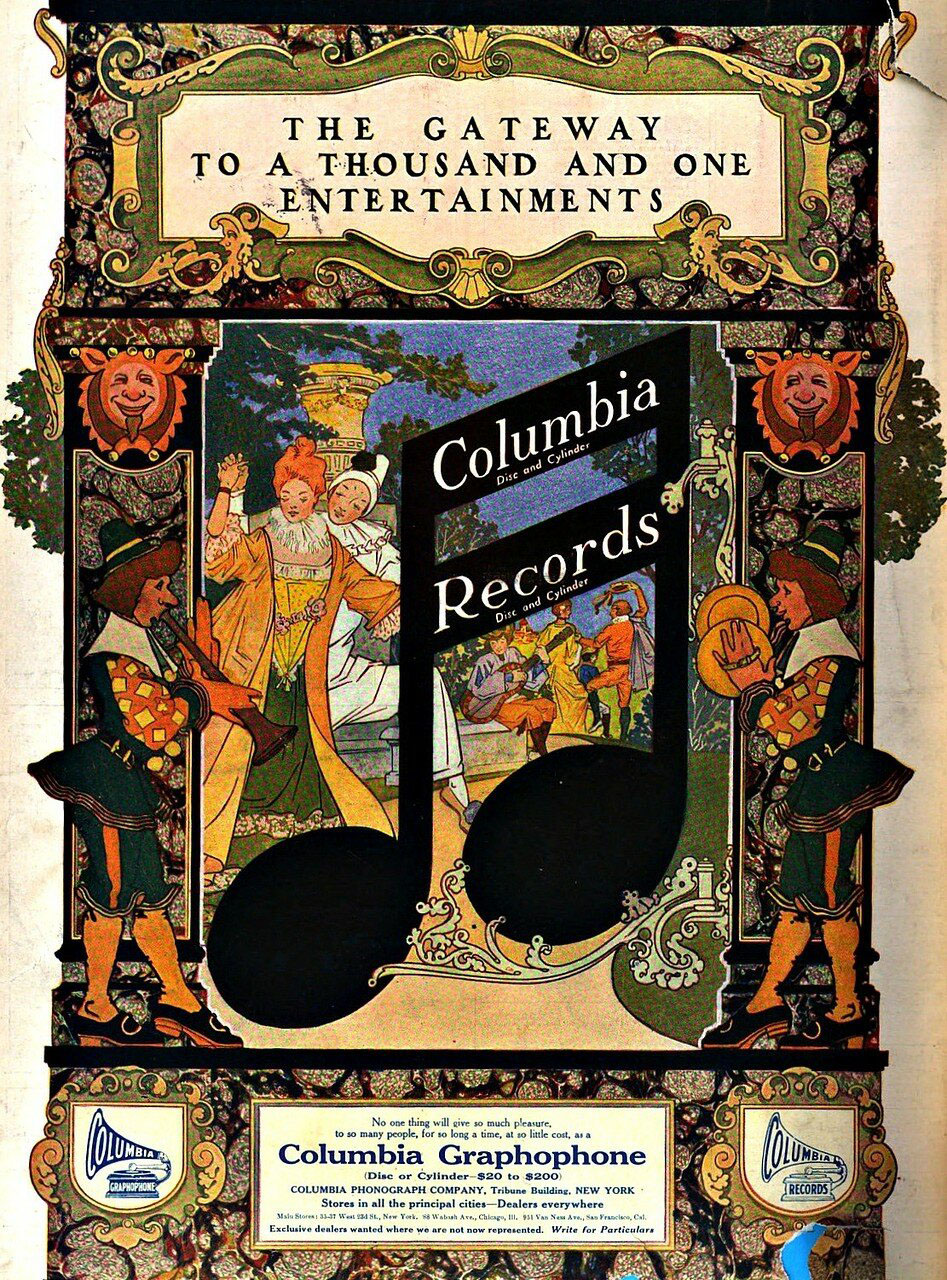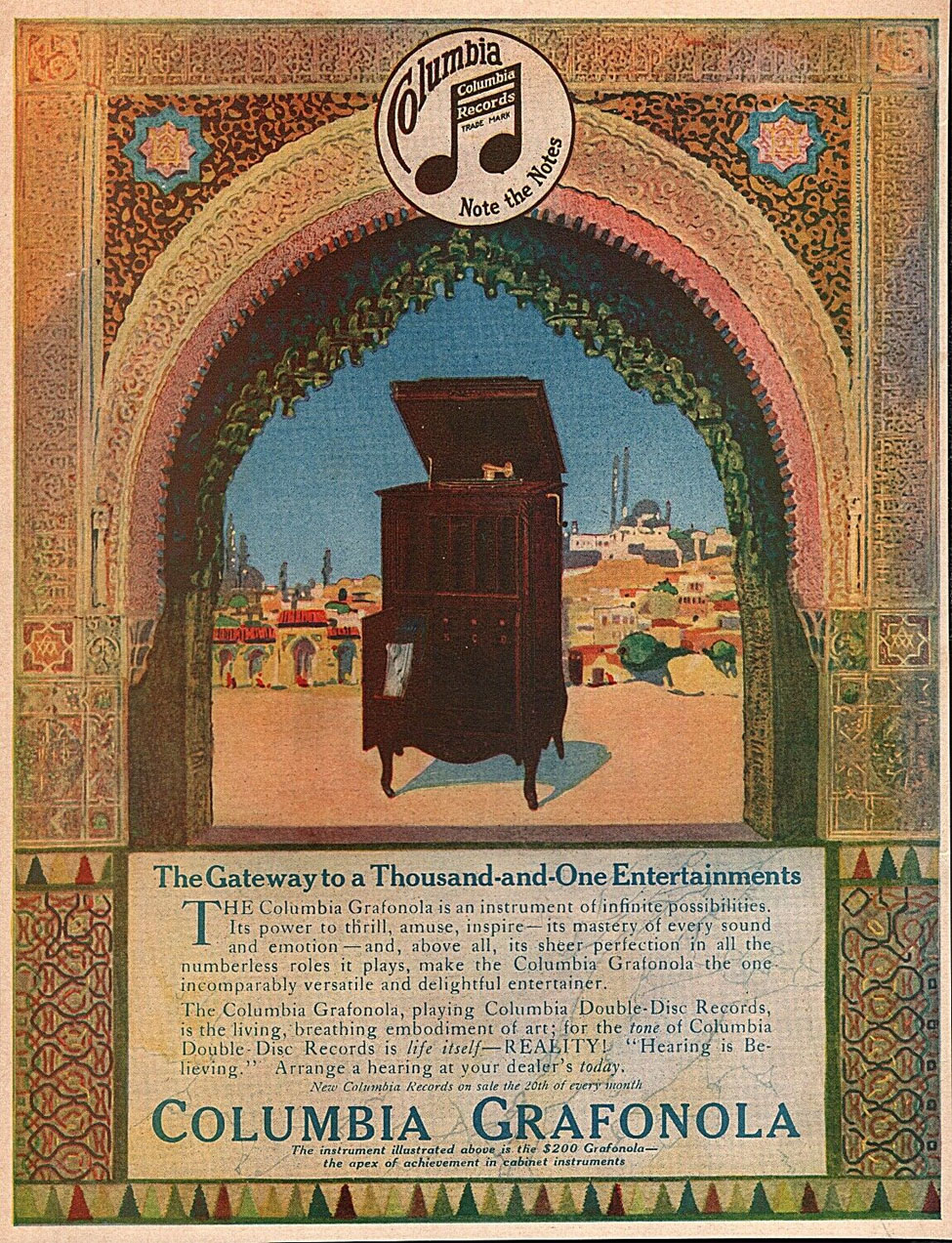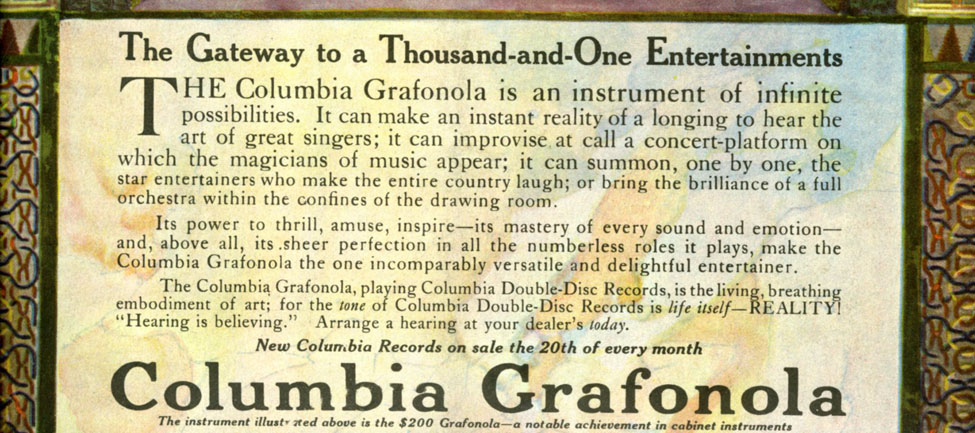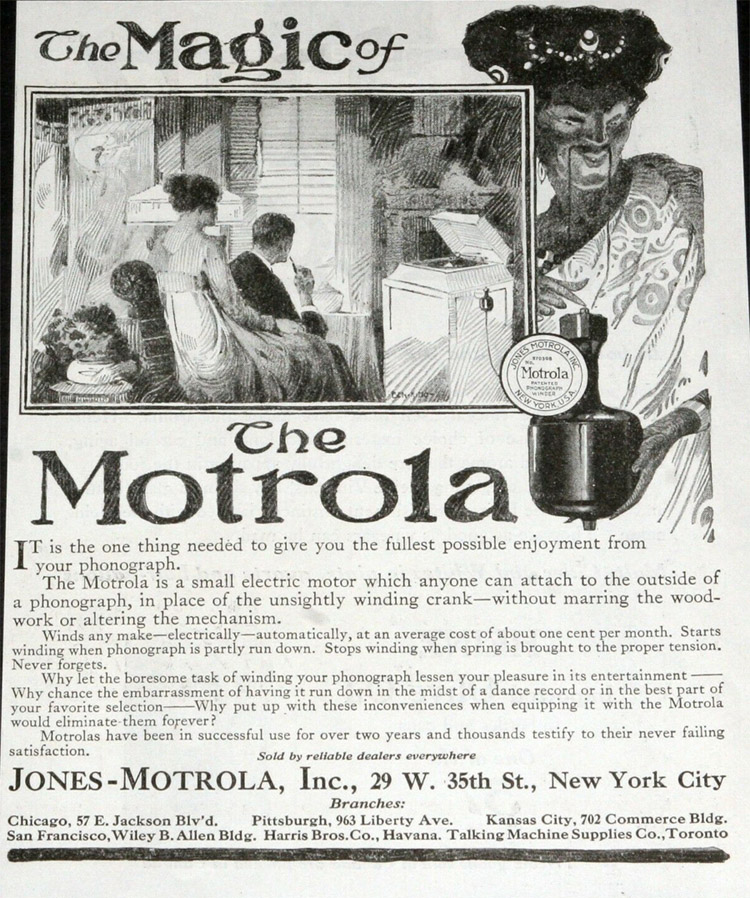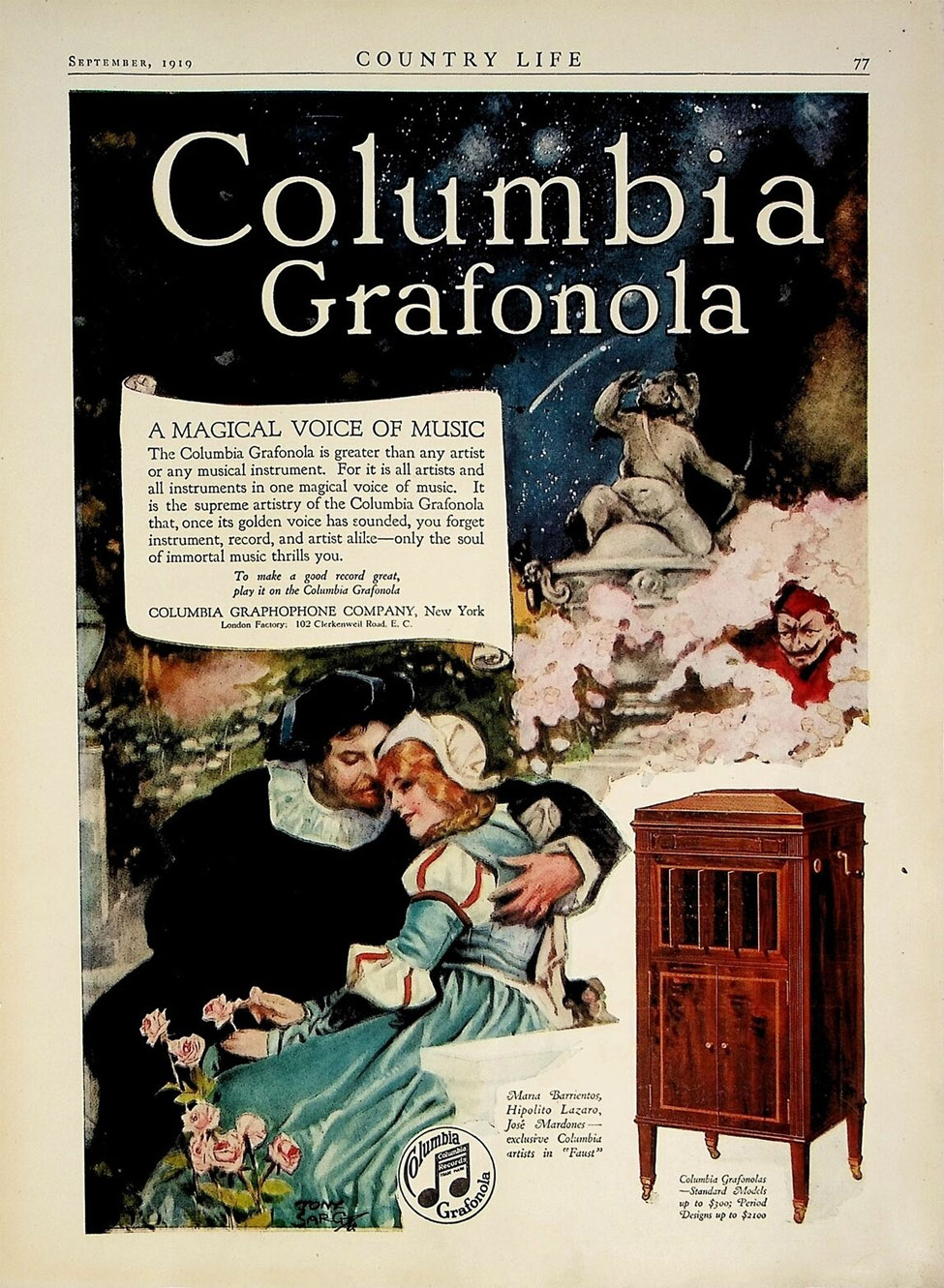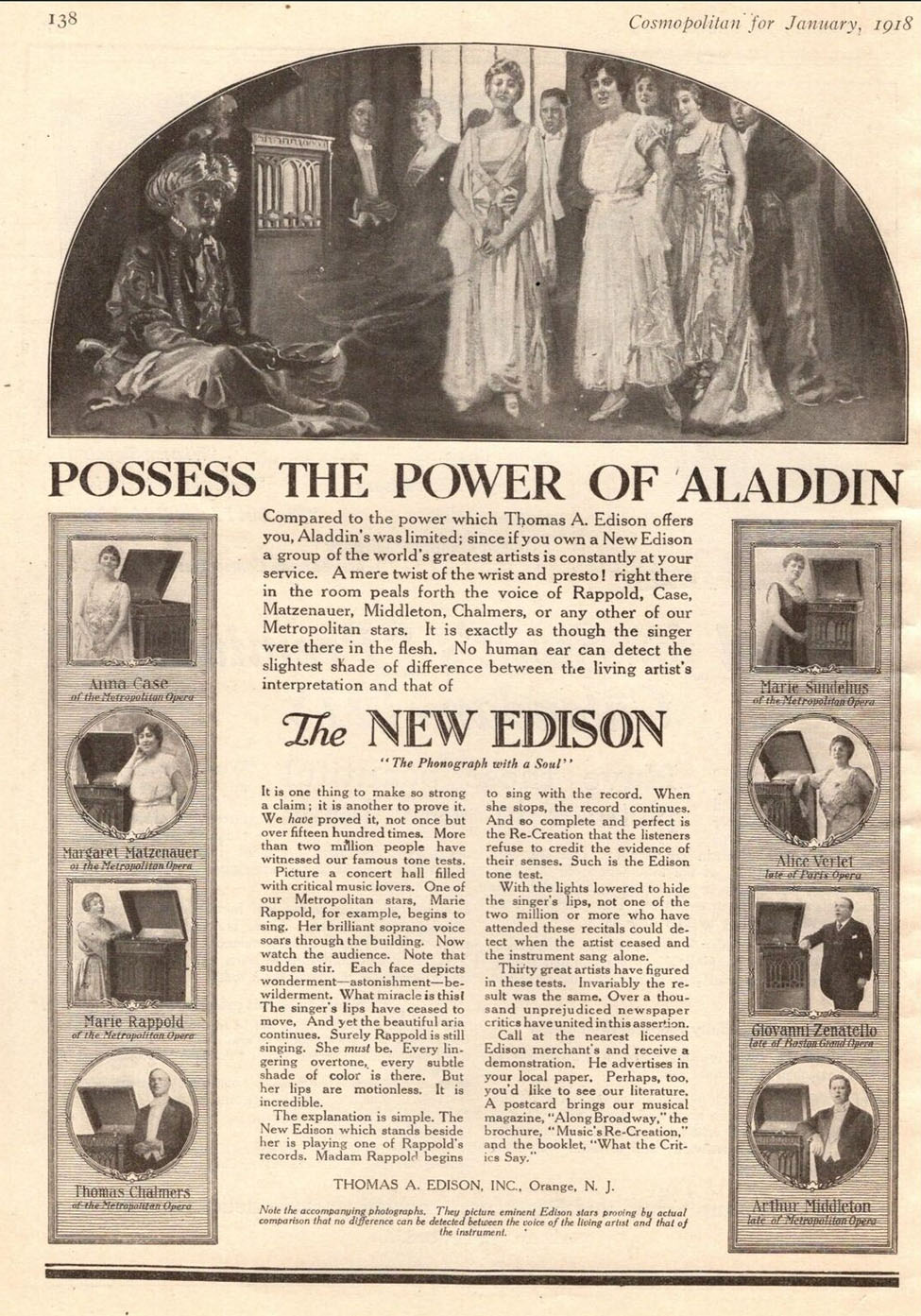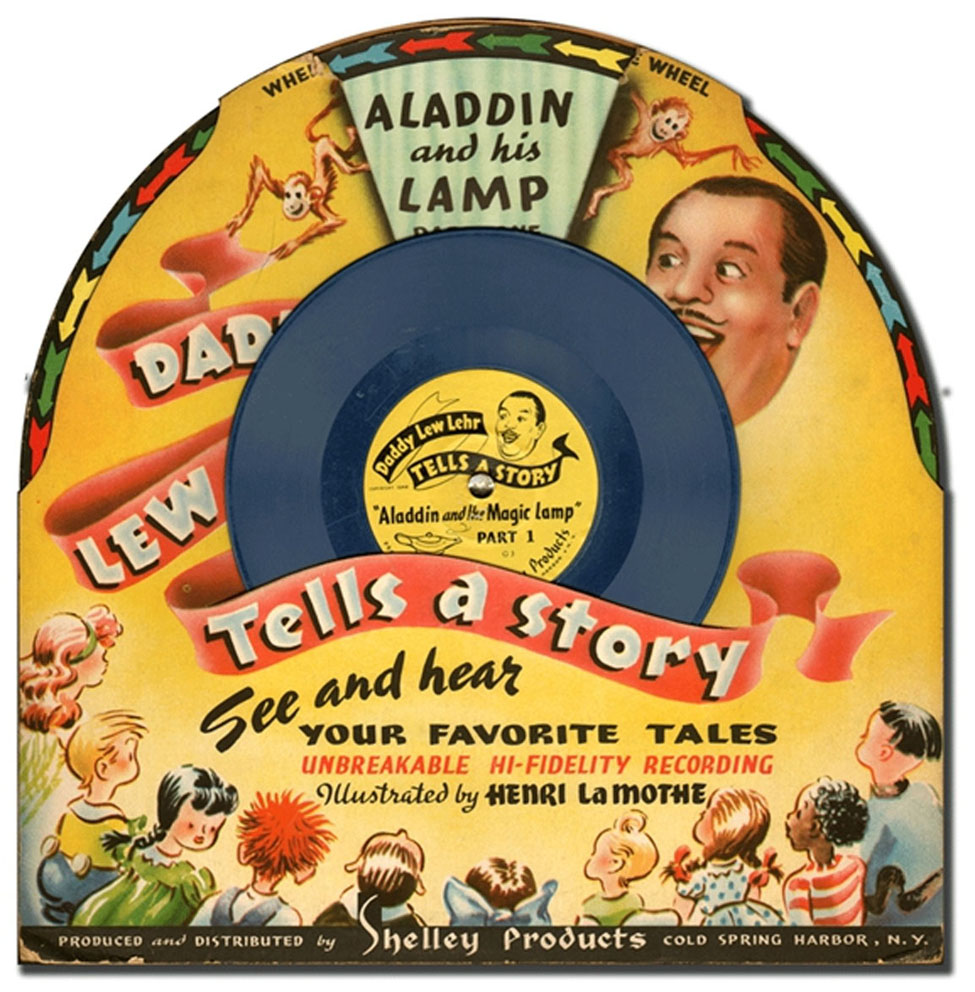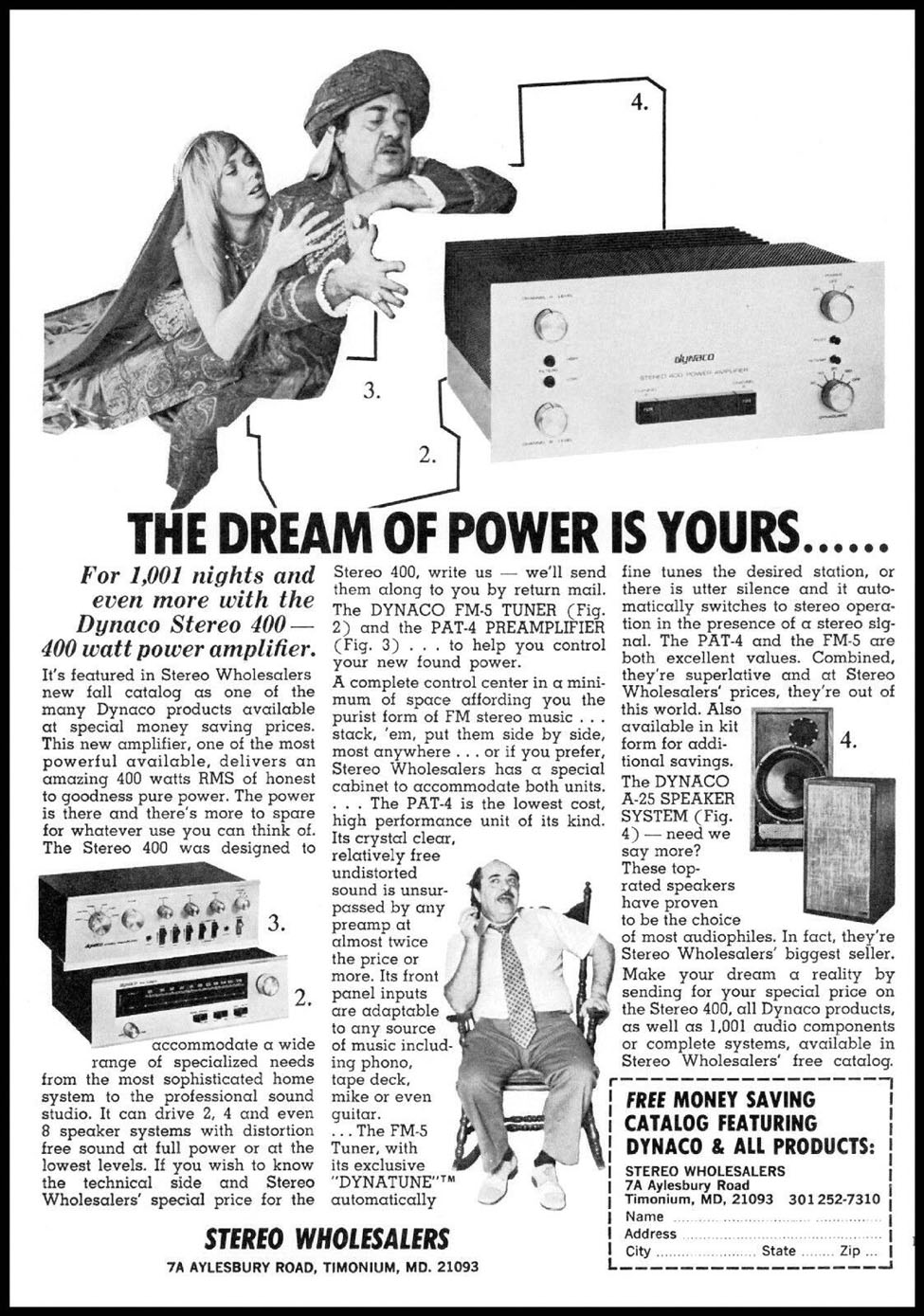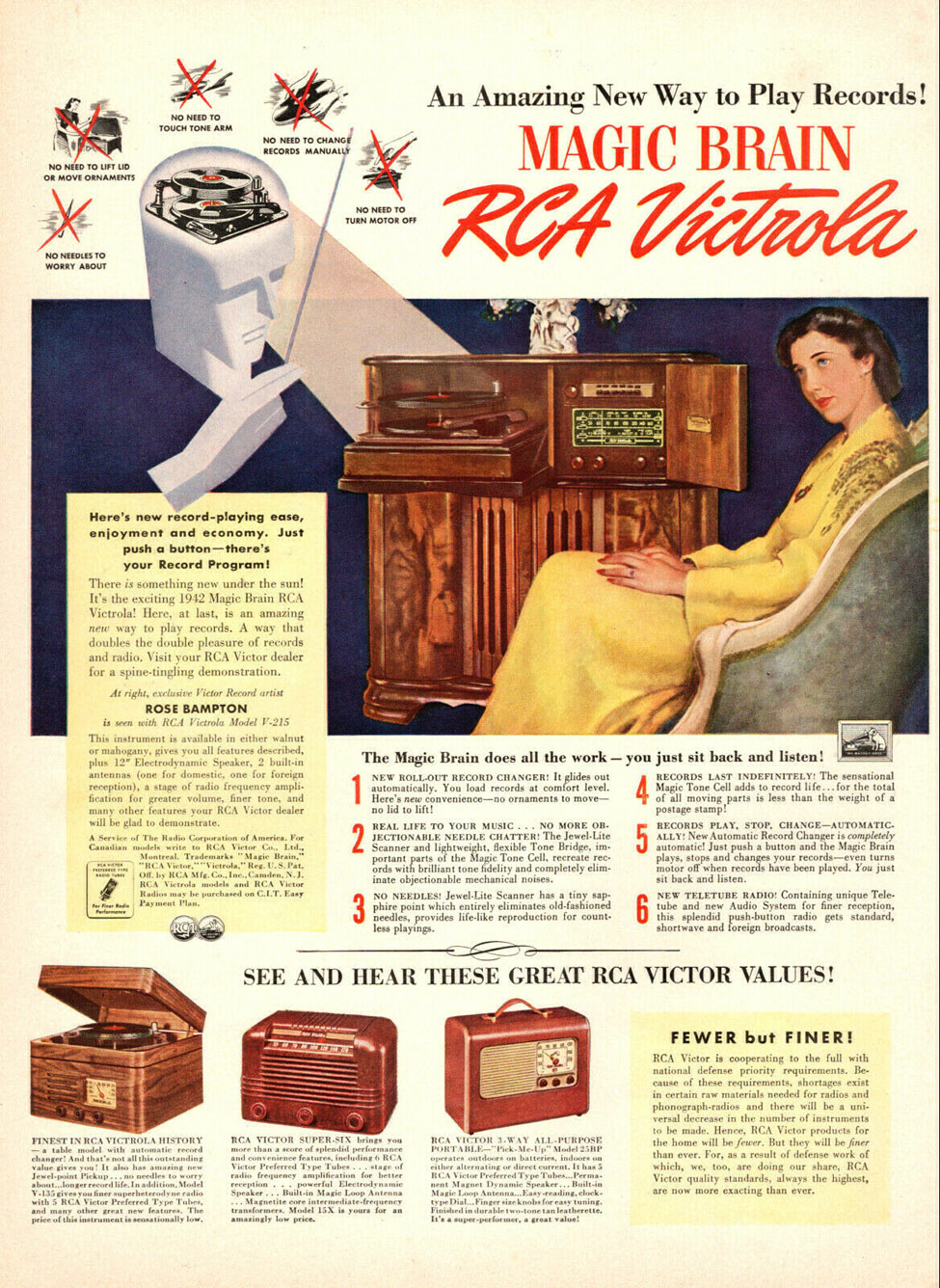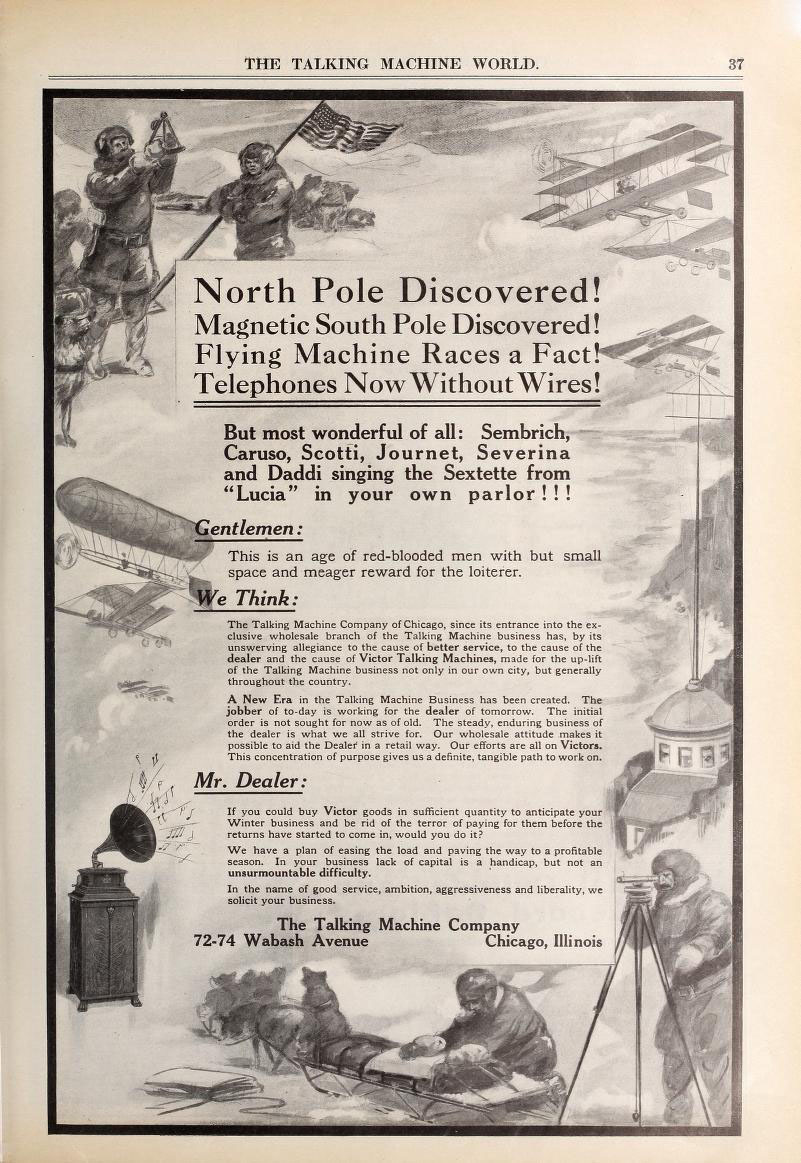An
Age of Wonders

Wonders, Wizardry,
Magic and Aladdin's Lamp
By Doug Boilesen, 2021
The "Age of Wonders" at
the end of the nineteenth century was an age of technological and
scientific achievements. It had many contributors but for "wonders"
created probably no person was better known in popular culture than
Thomas Alva Edison.
As seen in the illustration "The
Wizard’s Search," The Daily Graphic, An Illustrated
Evening Newspaper, July 9, 1879 the phonograph had earlier given
Edison the sobriquet "The Wizard of Menlo Park" (first
appearing in print on April 7, 1878 - see "How
Edison Got His Name - Origins of the Wizard" by Allen Koenigsberg).
In 1879 Edison was continuing in that wizard role with his search
for "light" and the electric light bulb and the infrastructure
that could bring electric light to every home. For
the public Edison seemed to have a magician's touch.
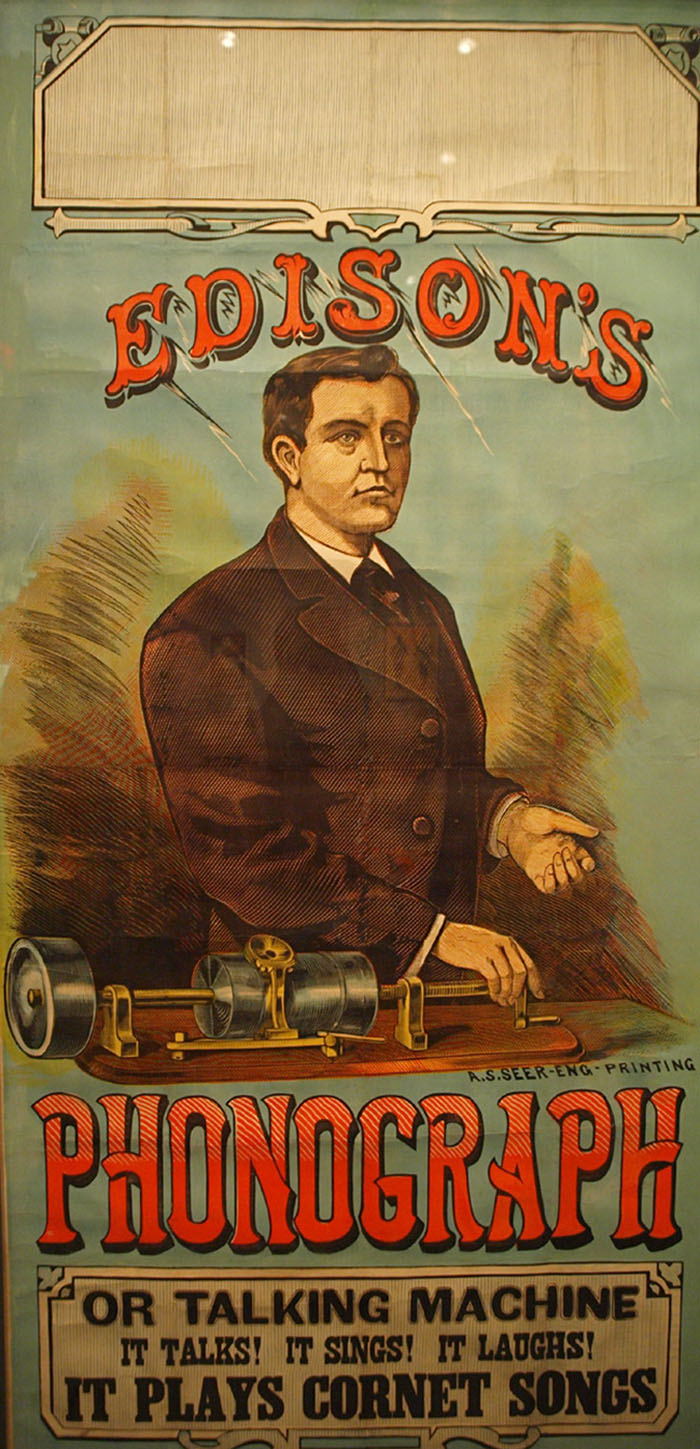
Edison's
Phonograph, 1878 - Poster
for demonstration of Edison's phonograph, 1878
Courtesy of National
Museum of American History - Smithsonian Institution
Harper's Weekly noted in 1878
that the days of the "belief in witchcraft were long since
past," yet the language of sorcery and magic could still be
used in the reporting of the early public demonstrations of Edison's
new phonograph. Readers understood why it could be written that
"...witch-hunters such as those who figured so conspicuously
in the early history of our country would now find a rich harvest
of victims" listening to a "new wonder called the phonograph."
("The Phonograph," Harper's Weekly, March 30,
1878).
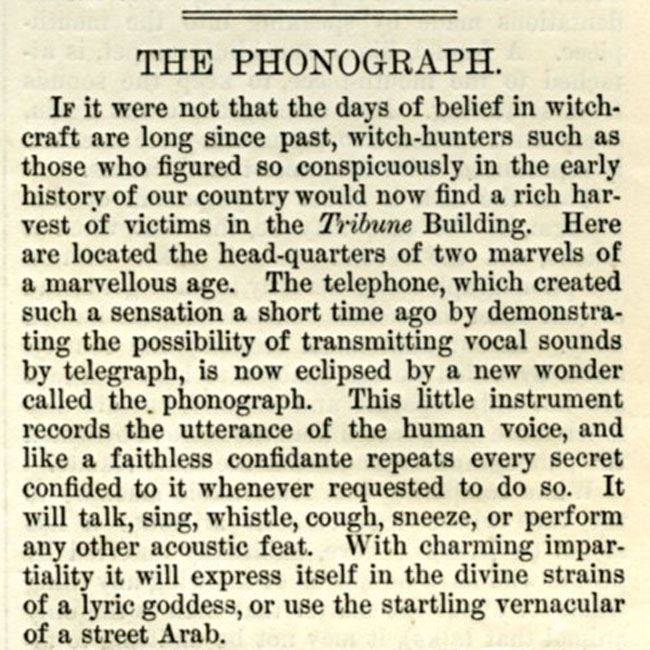
"the telephone,
is now eclipsed by a new wonder called the phonograph." March
30, 1878, Harper's Weekly.
"One of
the Wonders of Science"
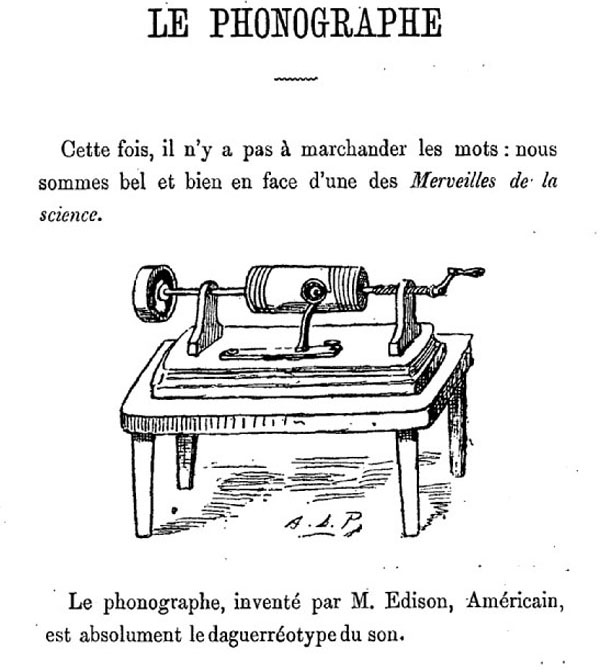
The 1878
Le Trocaderoscope,
described the Phonograph in a 'story' demonstrating the veracity
of the phonograph. That story and a short biography of Edison who
was promoted as an exhibitor at the fair (and who it was hoped would
attend but didn't) is part of a catalogue related to the 1878 Exposition
Universelle (a.k.a. the third Paris World's Fair which was held
from 1 May to 10 November 1878).
"This
time, there is no need to haggle over words: We are indeed in front
of one of the wonders of science.
The Phonograph,
invented by Mr. Edison, American, is absolutely the daguerreotype
of sound."
Think of all of the words
associated with "Wonder" e.g., something strange and surprising;
a cause of astonishment, awe, amazement, marvel, admiration.
The Phonograph was "one
of the wonders of science."
The
fact that the phonograph could record and play back the human voice
made it a 'wonder' from its beginning. Demonstrating the phonograph
as an early exhibition machine resulted in amusement and predictions
for its future. But it was the Bell-Tainter Graphophone and Edison
returning to work on his phonograph nearly ten years after its invention
when the phonograph revived its earlier 'wonder' talk in popular
culture. The 1889 Exposition
Universelle in Paris gave Edison's phonograph a large venue
where it was heard and praised on an international scale as a wonder.
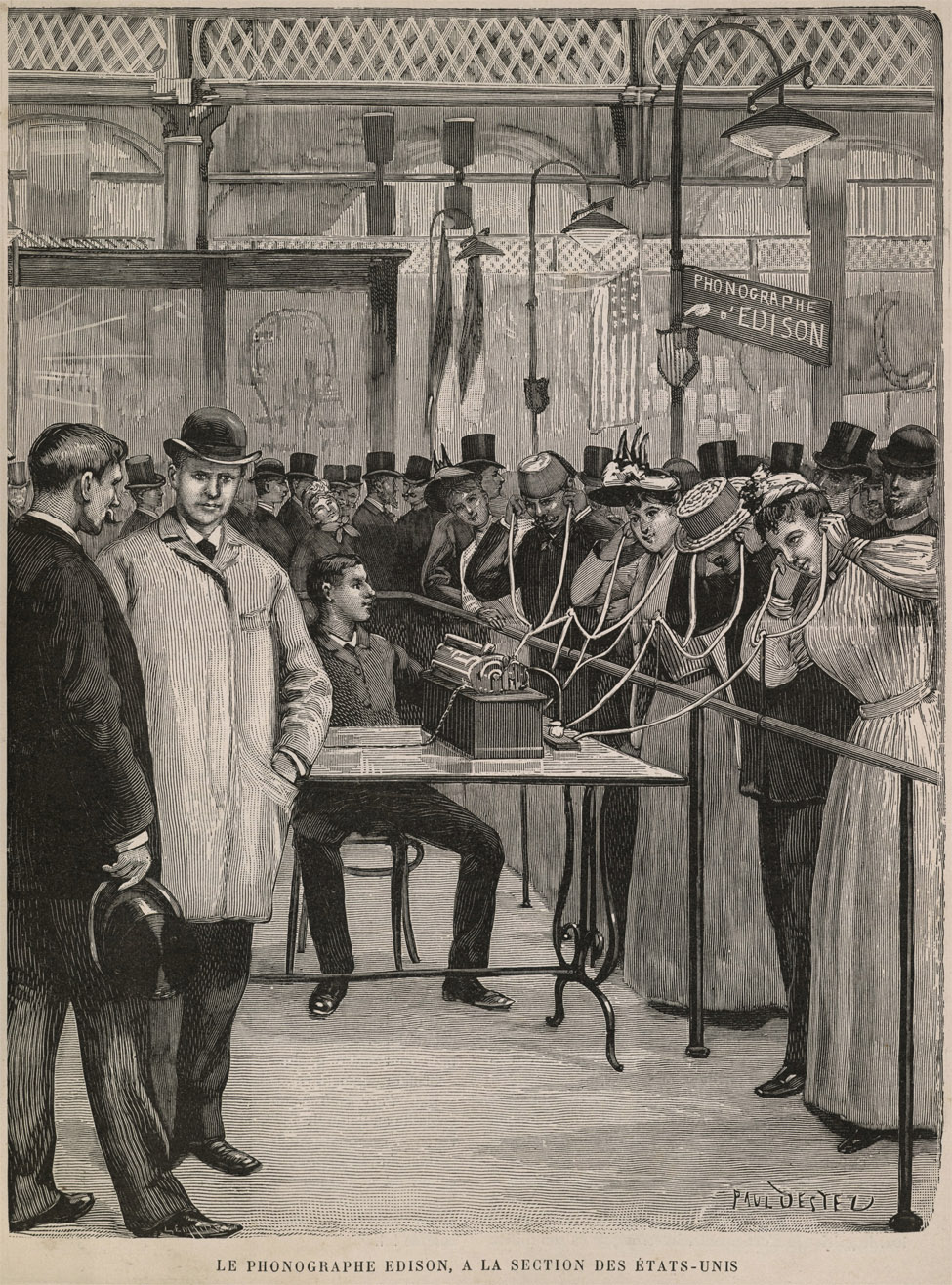
Edison's Phonograph being
demonstrated as part of the United States Exhibition Area by Paul
Uestel (PM-2079)

The Phonograph's "Alladin-like
tinge"
The Phonogram ("Devoted
to the Science of Sound and the Recording of Speech") featured
in its monthly section titled The Phonograph an article by
William Clarke on "Phonographic Possibilities" which he
said "of the present impregnable position of the phonograph,
the story of its progress has an Alladin-like tinge." (The Phonogram,
April, 1891, p. 86).
A Phonograph Panorama - Recording
reactions of first-time listeners to "Mr. Magician Phonograph"
(perhaps a "species of sorcery.")
A writer for the Phonogram in
June 1892 watched a phonograph placed where he could observe its effect
on first-time listeners. The article
describes several of the "amusing occurrences and a number
of striking scenes." Questions of "Can it tell fortunes?"
Can the machine talk Dutch and Choctaw? Some concluded that there
must be a man concealed in a cabinet; others were afraid they might
get an electric shock if they touch the listening tubes.
The writer's summary of the panorama
of listeners?
"Time would fail any one who
would undertake to record all the odd fancies conjured up by this
unique apparatus in the brain of the ordinary visitor. So few in
a crowd are acquainted with the possibilities of mechanism and its
automatic powers, that they insensibly incline to the opinion that
there is something rather uncanny in it, a species of sorcery, as
it were. It will probably take a generation to learn that it is
invented solely by the wit of a genius."
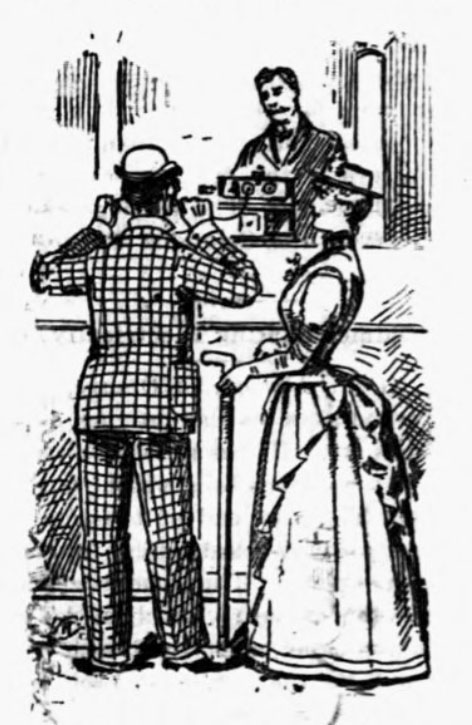 
The Phonogram in
June, 1892
The Phonograph, one of the electrical
wonders anticipated to be seen at the World's Columbian Exposition.
In anticipation
of the 1893 Chicago World's Columbian Exposition The
Examiner, San Francisco in April 24, 1891 wrote that the phonograph
was one of the wonders to be exhibited at the world's fair's
"Electric House" where many uses of electricity for the
home would be displayed.
The kitchen
was to have electrical appliances like an electric range, electric
dishwasher; the washing, ironing and scrubbing of the floors and woodwork
would all be electrically performed and even the washing of the windows
would be done by electricity. "In
the parlor would be a "phonograph and cylinders containing celebrated
speeches by celebrated men, and songs by celebrated women. "In
the sanctum of the master of the house for the purposes of his business"
would be a telephone and "a portable phonograph with cylinders,
for mailing a conversation to any point."
The following picture from
The Book of the Fair shows the portion of Edison's exhibit
in the Exhibition's Electricity Building which had an Edison electric
(battery powered) phonograph on display with tubes for multiple listeners.
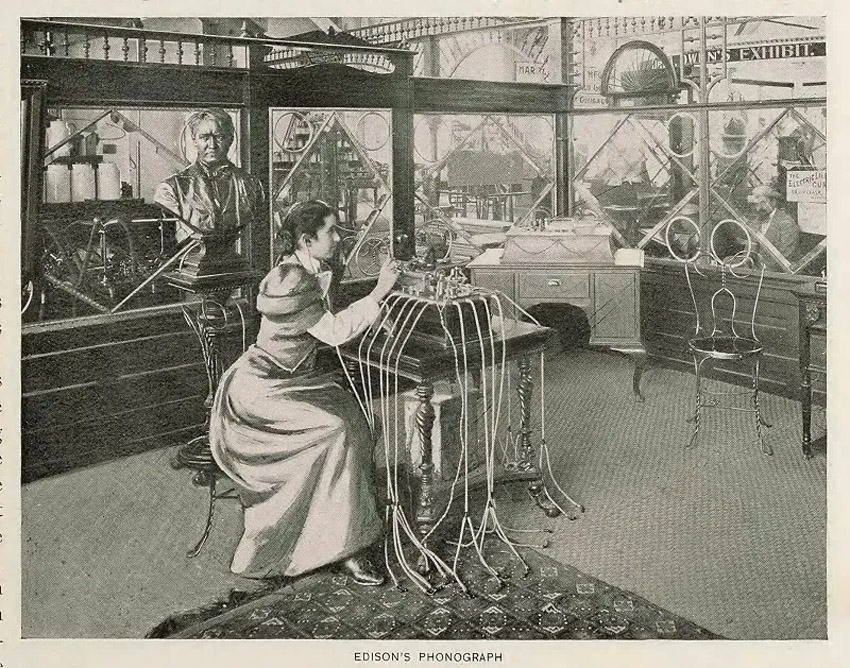
Thomas Edison’s phonograph
exhibit in the Electricity Building. (Image from Bancroft, Hubert
Howe's The Book of the Fair. The Bancroft Company, 1893.) (1)
"Open-mouthed
wonder"
Coin-operated phonographs
were also at the 1893 fair and were a popular entertainment for exhibition
visitors. The Adventures of Uncle Jeremiah and Family at the Great
Fair by Charles McCellan Stevens is an example of the new category
of "fair fiction"
literature featuring stories about families visiting the World’s Columbian
Exposition of 1893 and enjoying the phonograph.
In Stevens' book we see the reaction of Uncle Jeremiah and his family
as they listen "in open-mouthed wonder" to the nickel-in-the-slot
machines.
"The first objects
that met their gaze were the graphophones or phonographs. Some nickels
were soon in the slots and the family for the first time listening
to music coming from some where by singers unseen...
Between each verse Johnny told the boy who stood in open-mouthed
wonder near him that the "feller is a singer from way back." He
could not realize that he was not in a concert hall and that all
standing about were not hearing what he heard. When the music ceased
and he withdrew the tubes from his ears he said to the boy, "Wasn't
that out of sight?"
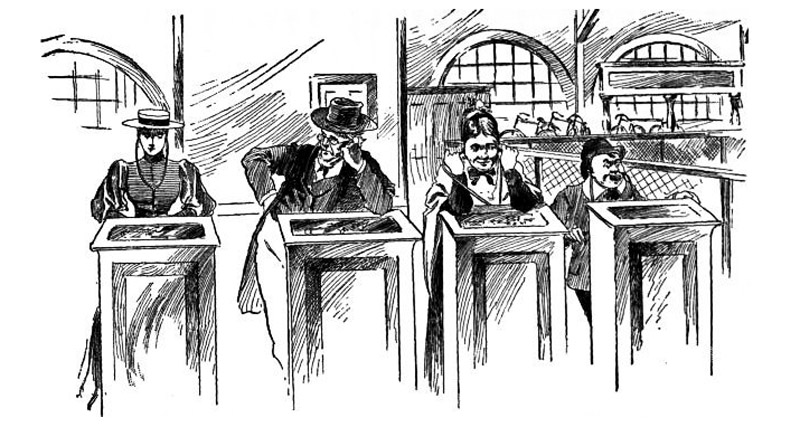
"They listened to melodies by
musicians unseen, and from somewhere unknown."
The Adventures of
Uncle Jeremiah and Family at the Great Fair by Charles McCellan
Stevens, Chicago, Laird and Lee, ©1893
A Wonder Never Built
The last paragraph of The
Examiner's 1891 article about the Electric House describes
what would have been another wonder if it had been built as proposed.
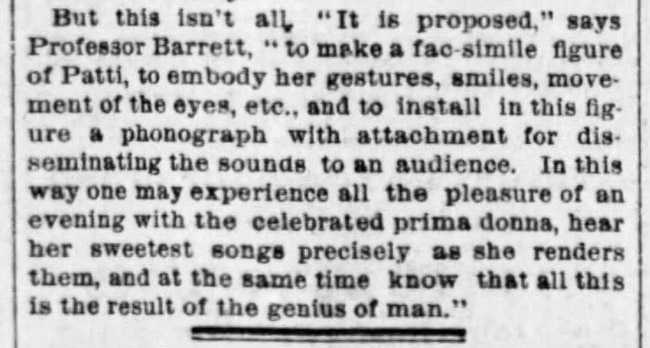
The Examiner,
San Francisco, April 24, 1891
The proposed facsimile
figure of Adelina Patti with a phonograph inside her was never built.
Patti did make a recording circa 1890 but it has been lost and its
title is unknown.(2).
However, an Edison phonograph
was used inside a large figure of Uncle Sam, and it did deliver recorded
speeches promoting Hub Gore Shoes.

Trade card showing Uncle Sam promoting
Hub Gore shoes at the 1893 Columbian Exposition with an Edison Phonograph
providing his sales 'speech.'
UNCLE SAM'S SPEECH.
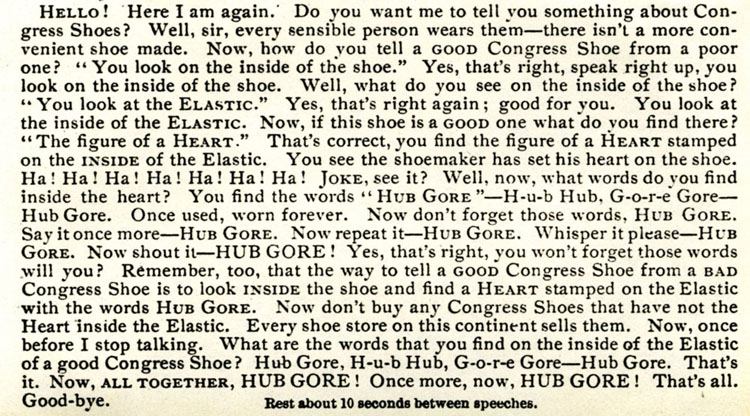
Courtesy of The Warshaw
Collection of Business Americana, Archives, Smithsonian Institution
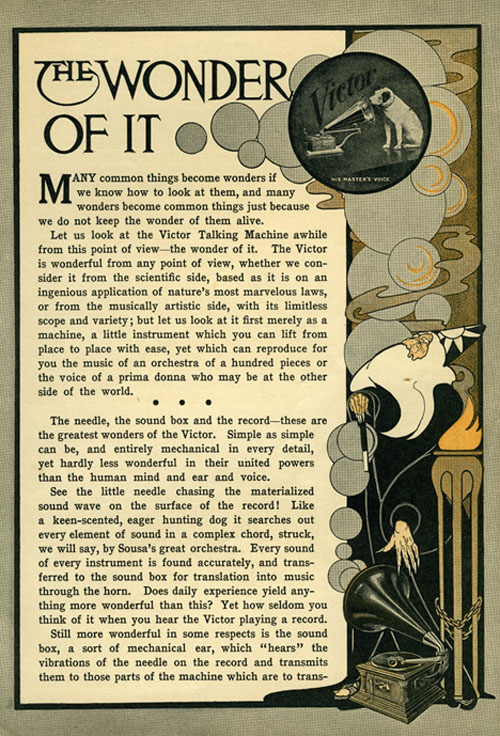
Victor Advertising Brochure
1906 - "Does daily experience yield anything more wonderful than this?"
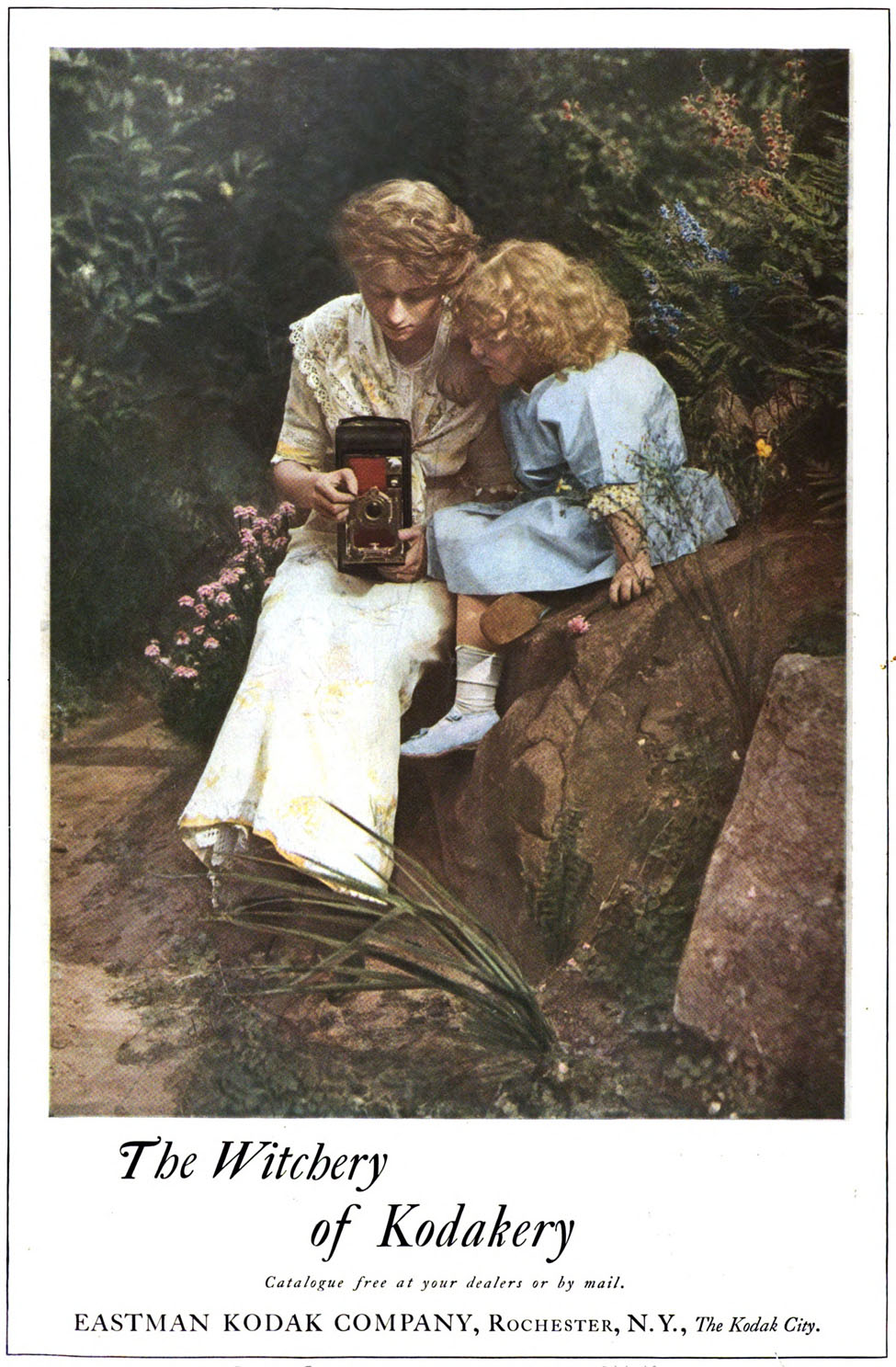
Witchery and the magic of photography
ran parallel in popular culture with the phonograph. The Ladies'
Home Journal, June 1913
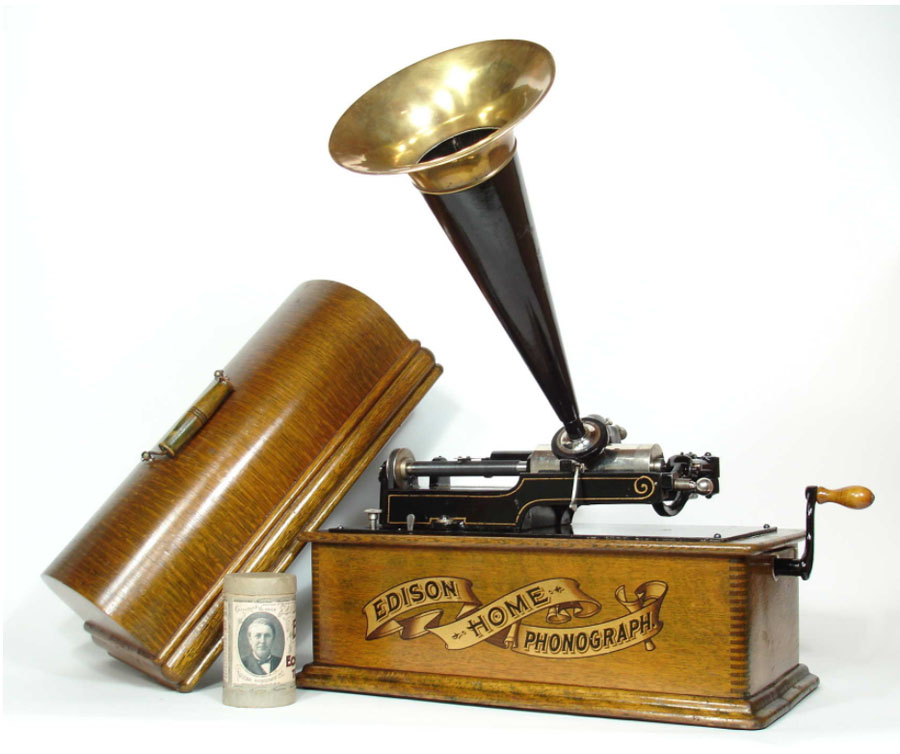
Edison Home Phonograph,
Model A with 14" horn known to modern collectors as a "Witches
Hat Horn" circa 1904 (courtesy Technogallerie).
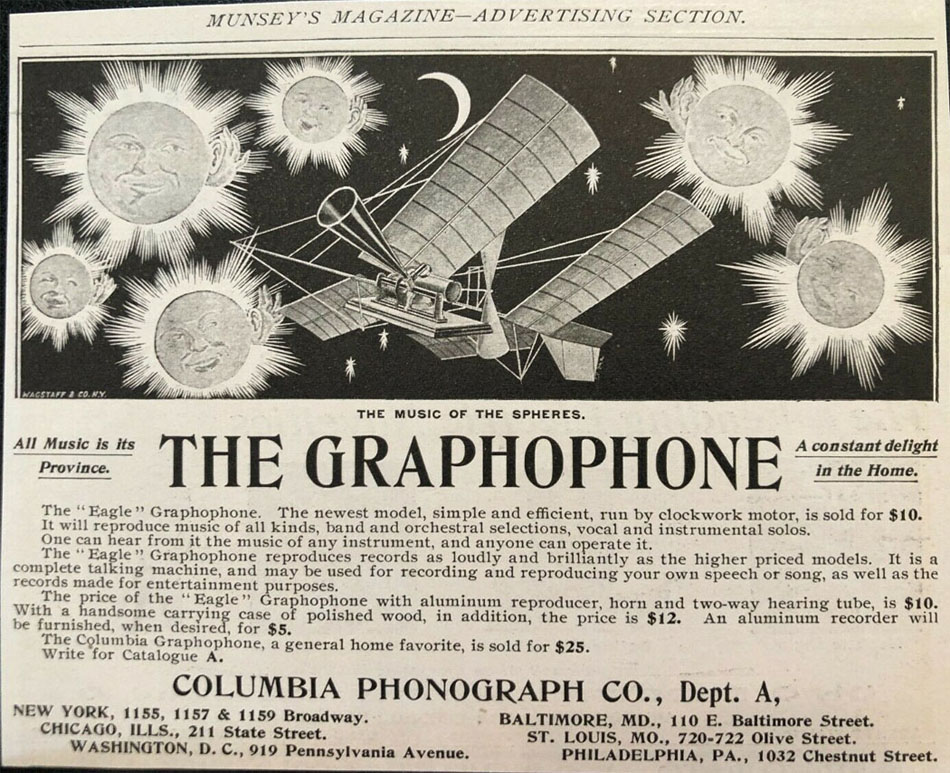
The Music of the Spheres. All Music is its Province.
Munsey's Magazine,
October 1897
"Most Wonderful
of All..." the phonograph playing music "in your own parlor!!!"
The Talking Machine
World, November 15, 1909
The "most wonderful of all"
in the above ad ends with hearing the "Sextette from "Lucia"
in your own parlor!!!"
FACTOLA: In Mari Sandoz's "recollection"
short story The
Christmas of the Phonograph Records
her father's extravagant and much anticipated Phonograph
is delivered to their isolated homestead in western Nebraska just
in time for Christmas. The first cylinder record they play is the
Sextet from Lucia. Mari remembers that moment
of hearing Lucia as "what still seems to me the
most beautiful singing in the world."
"Like
turning Iron into Gold"
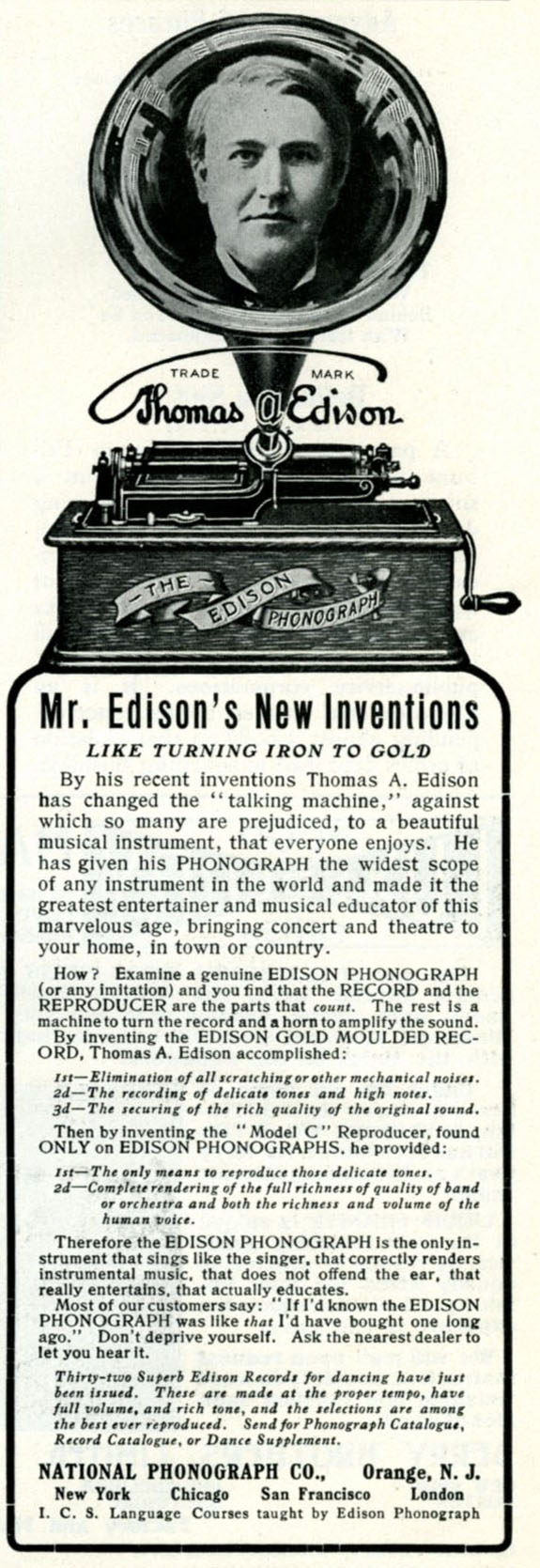
The talking machine has
been transformed by Edison into "a beautiful musical instrument."
The Booklovers Magazine World, 1905.
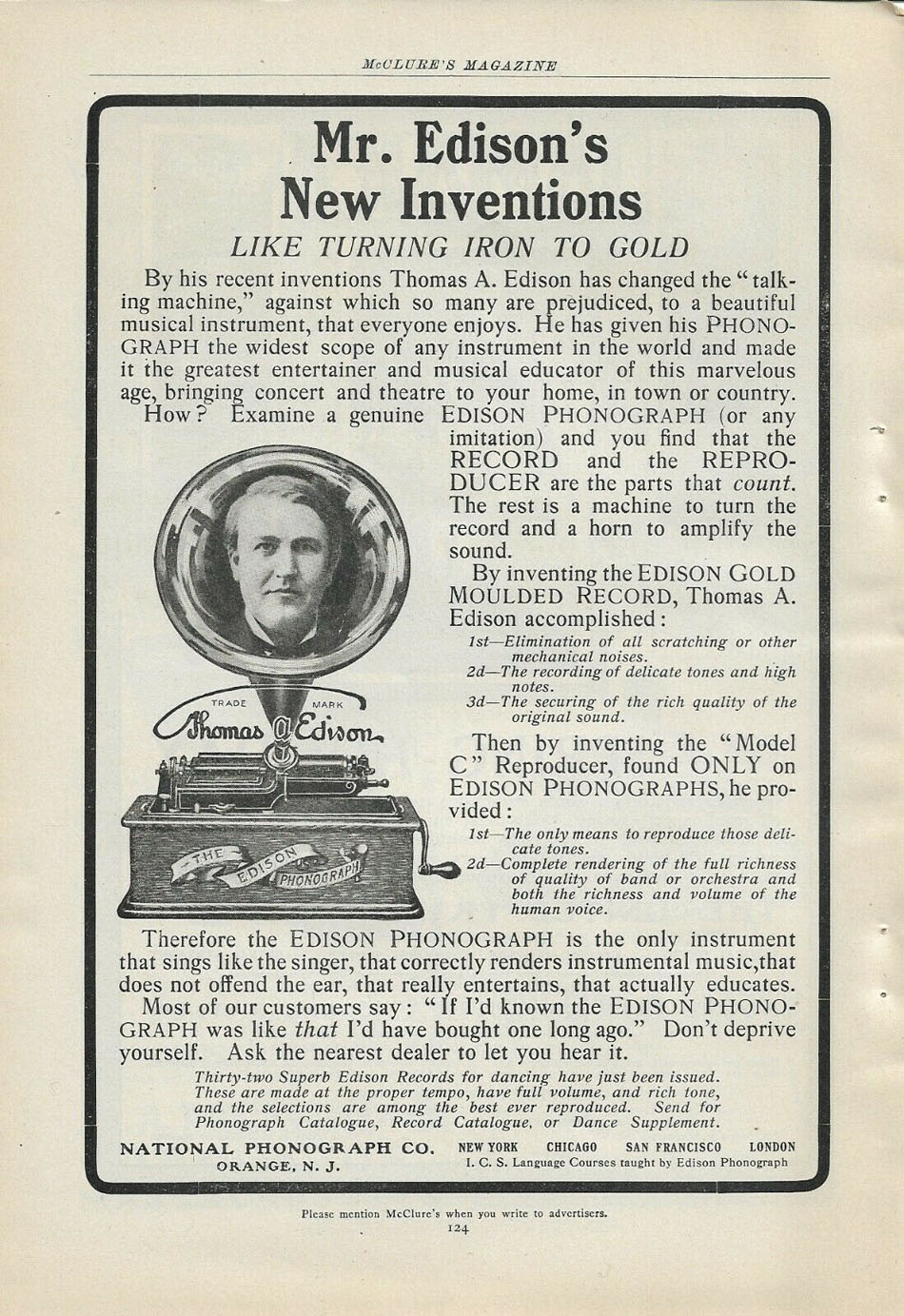
"Like Turning Iron
to Gold," McClure's Magazine, 1905.
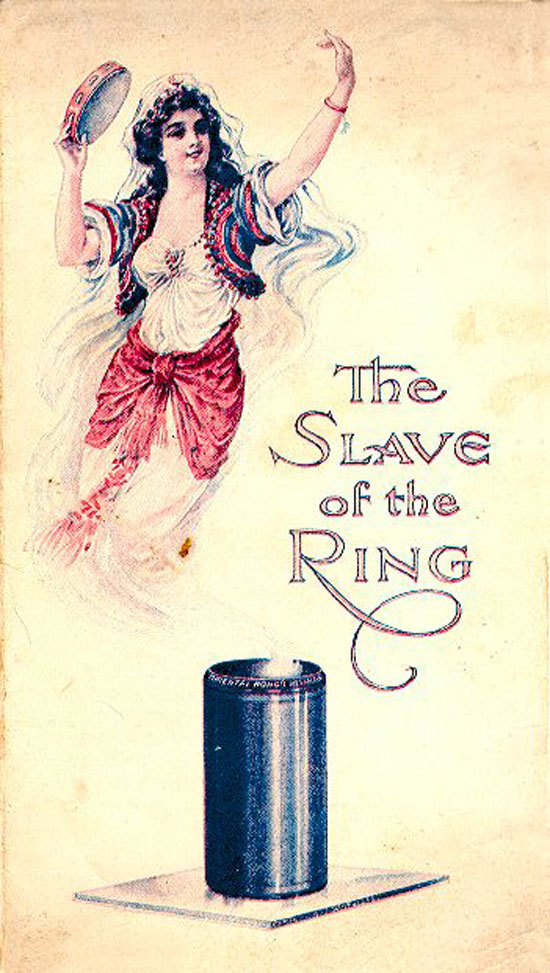
Edison's Genii of Entertainment,
rising from an Edison Gold Moulded Record, Form 690, September 1905.
.

The Edison Phonograph Monthly,
February 1907.
"The Loftiest Flight of Inventive
Genius," American Magazine, February 1906.
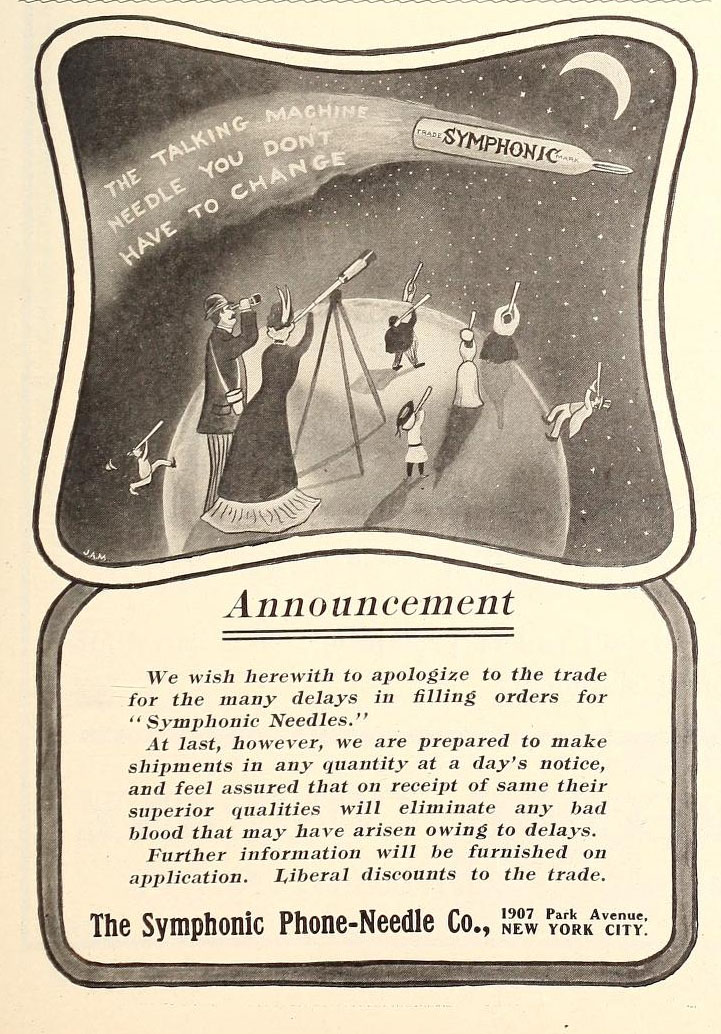
The Talking
Machine World, August 15, 1906

"The Halley Comet Visible
Only Every 75 years - The Victor Is Visible Every Day."
The Talking Machine World, April 1910.
The Gateway to One Thousand
and One Entertainments, Collier's, 1908.
"the
mystic, weird machine... summons spirits of the past for our delight"
The Phonograph - Our Genii counterpart
serving our least command!

The New Phonogram as reprinted
in The Talking Machine World, September 1911.
The Wizard Phonograph, ca.1911
The Wizard Phonograph
was made by the International Phonograph Company in Newark, New
Jersey around 1911. "The design was an attempt to avoid patent
infringement problems with Edison. The "Wizard" name was an obvious
reference to Edison, who was known as the Wizard of Menlo Park."
Photo and text courtesy of MusicalTreasuresofMiami.
The Gateway to a Thousand-and-One
Entertainments, 1916.
"it can improvise at call a concert-platform
on which the magicians of music appear...The Gateway to a
Thousand-and-One Entertainments" 1916 (PM-2014).
"Unsightly winding crank can
now be replaced with electric motor "to give you fullest possible
enjoyment from your phonograph." The Magic of the Motrola,
1918.
A Magical Voice of Music, Country
Life, September 1919.
"The Spirit
of Music" instantly transported by the Columbia Grafonola.
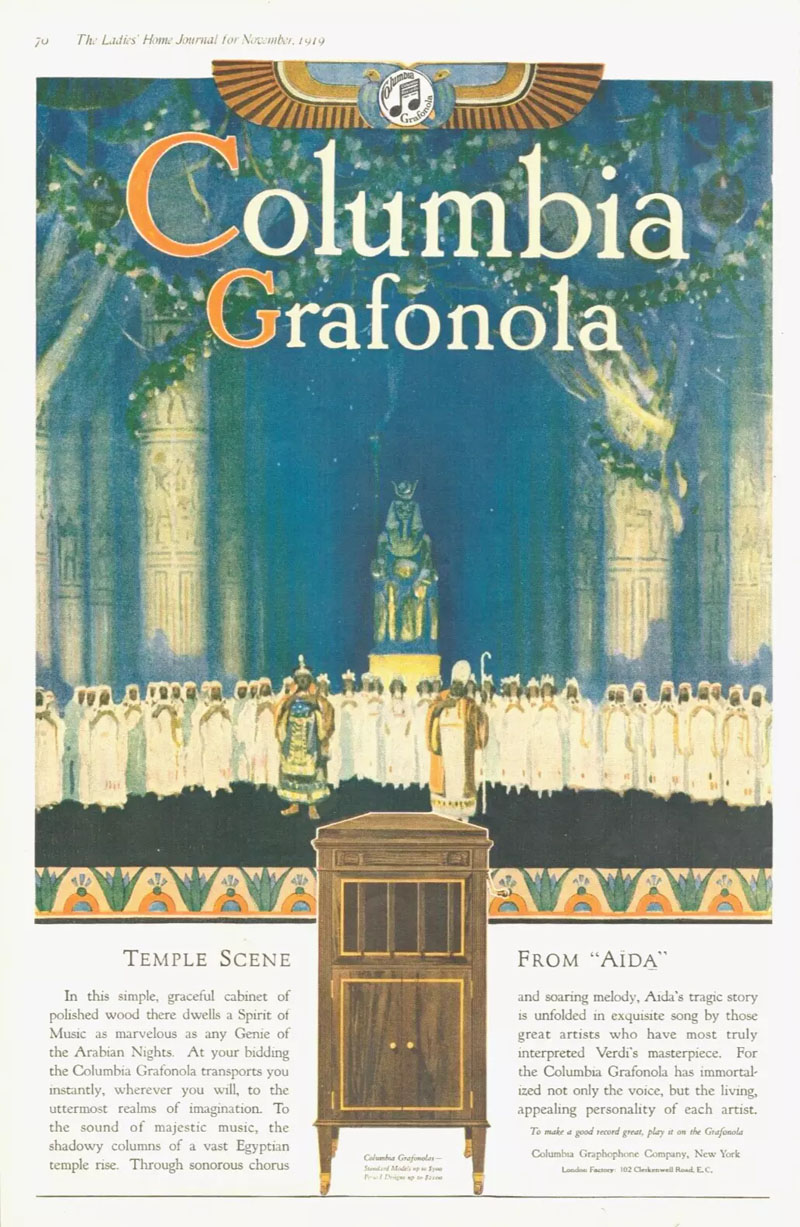
"In this simple,
graceful cabinet of polished wood there dwells a Spirit of Music
as marvelous as any Genie of the Arabian Nights." The
Ladies' Home Journal, 1919.
"Possess the Power of Aladdin"
Cosmopolitan for January 1918.

Melco Radio is a Silver-tongued Scheherezade,
The Talking Machine World, January 15, 1925.
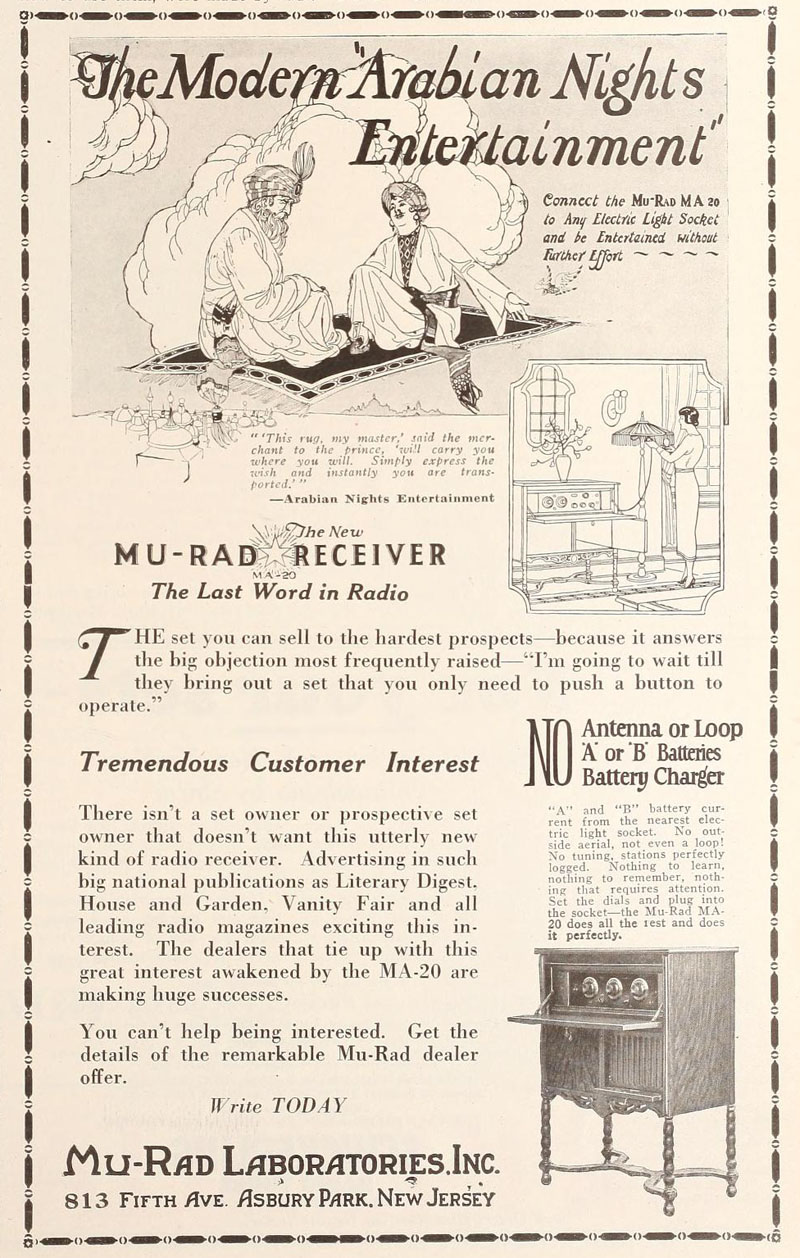
The MU-RAD Receiver "The Last
Word in Radio" for The Modern Arabian Nights Entertainment,
The Talking Machine World, February 15, 1925.

Melco Radio is The Magic Carpet, The
Talking Machine World, February 15, 1925.
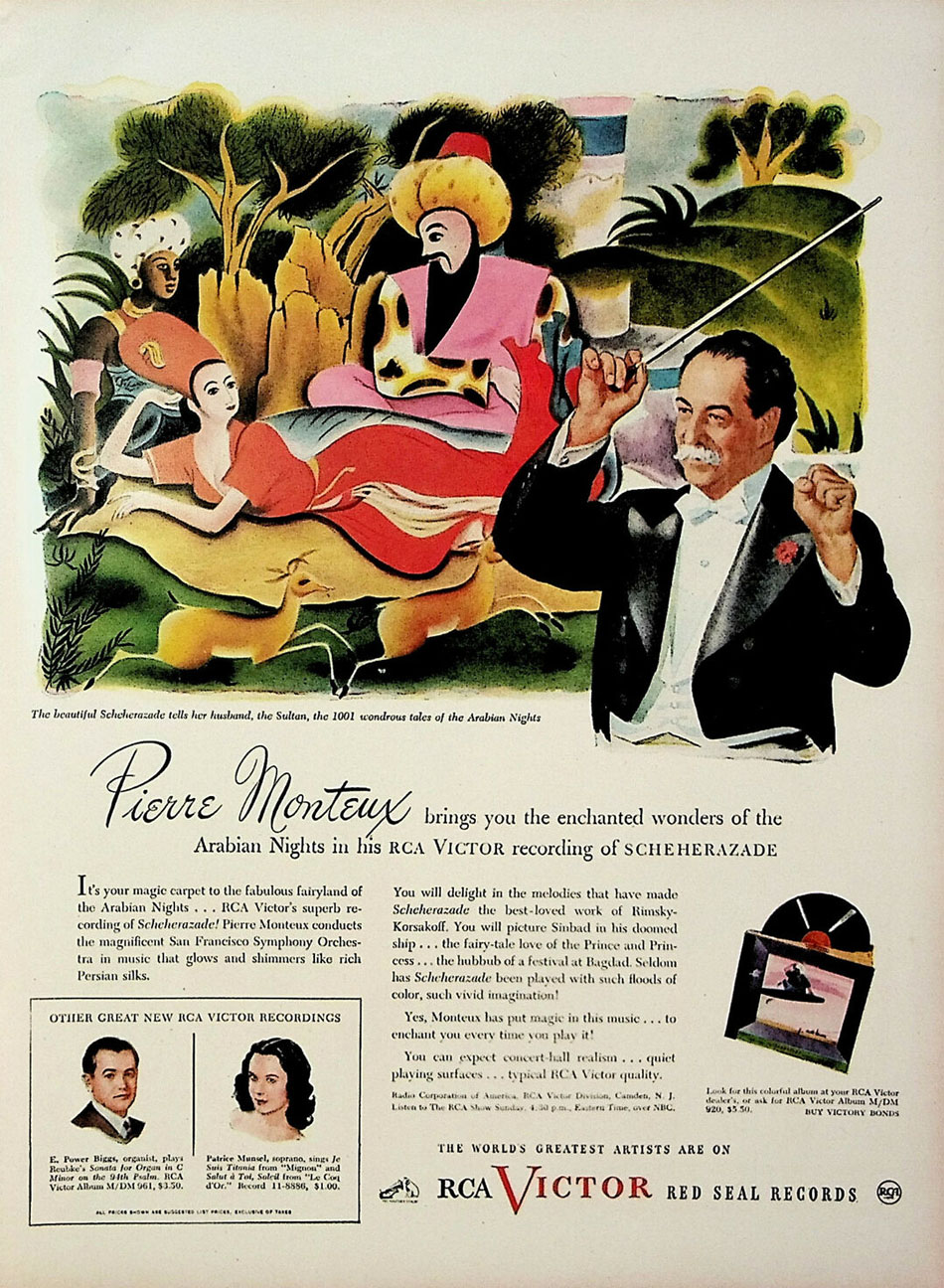
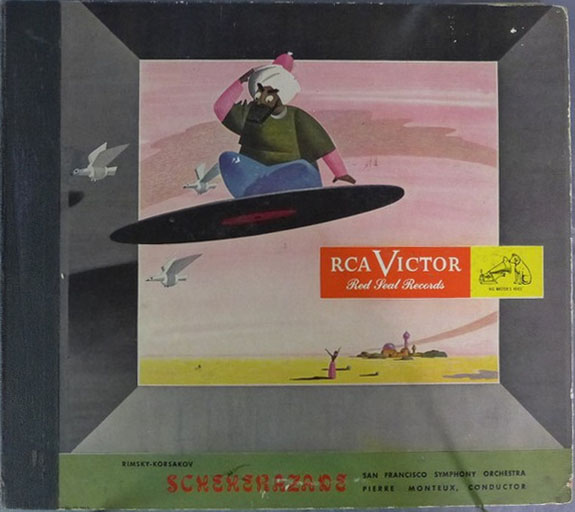
Scheherazade,
RCA Victor Record Album M/DM 920, 1942 (5 record album 78 RPM).
"Daddy Lew Lehr Tells a Story"
Point of Sale display for his "See and hear" recording
of "Aladdin and the Magic Lamp" circa 1948.

Westinghouse Radio-Phonograph Magic,
Country Gentleman, January 1948.
"For 1,001 nights and even
more..." Stereo Wholesalers ad, 1973.
"The exciting 1942
Magic Brain RCA Victrola! "An amazing new way to play
records." The Magic Tone Cell recreates records with brilliant
tone fidelity...and the sensatonal Magic Tone Cell adds to record
life..." Built in "Magic Loop Antenna" in the RCA
Victor Super-Six radio." The Magic Brain does all the work
-- you just sit back and listen!"
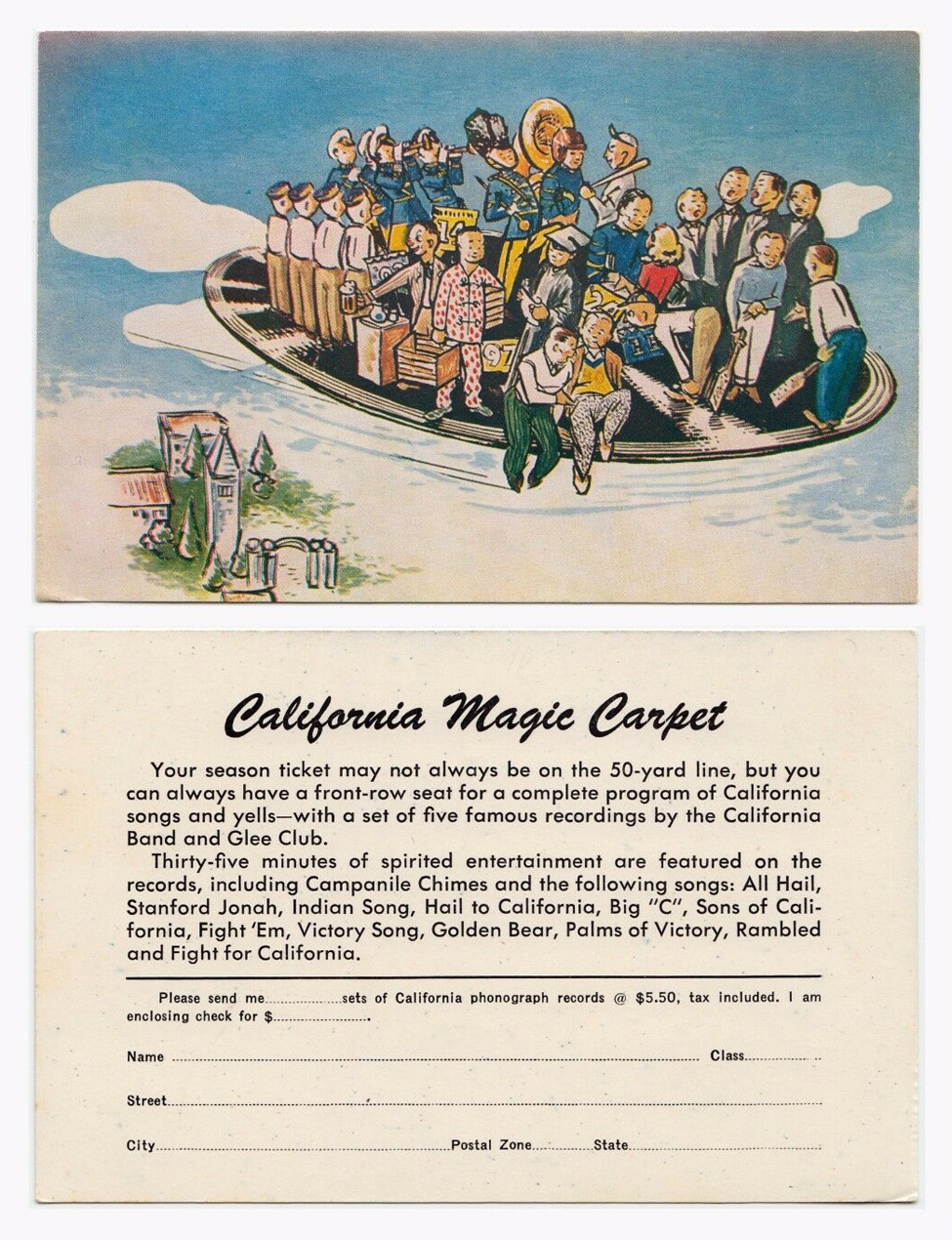
California Magic
Carpet postcard (front and back) advertising LP record by the
UC Berkeley California Band and Glee Club, 1955.
'...you can always have
a front-row
seat for a complete program of California songs and yells..."
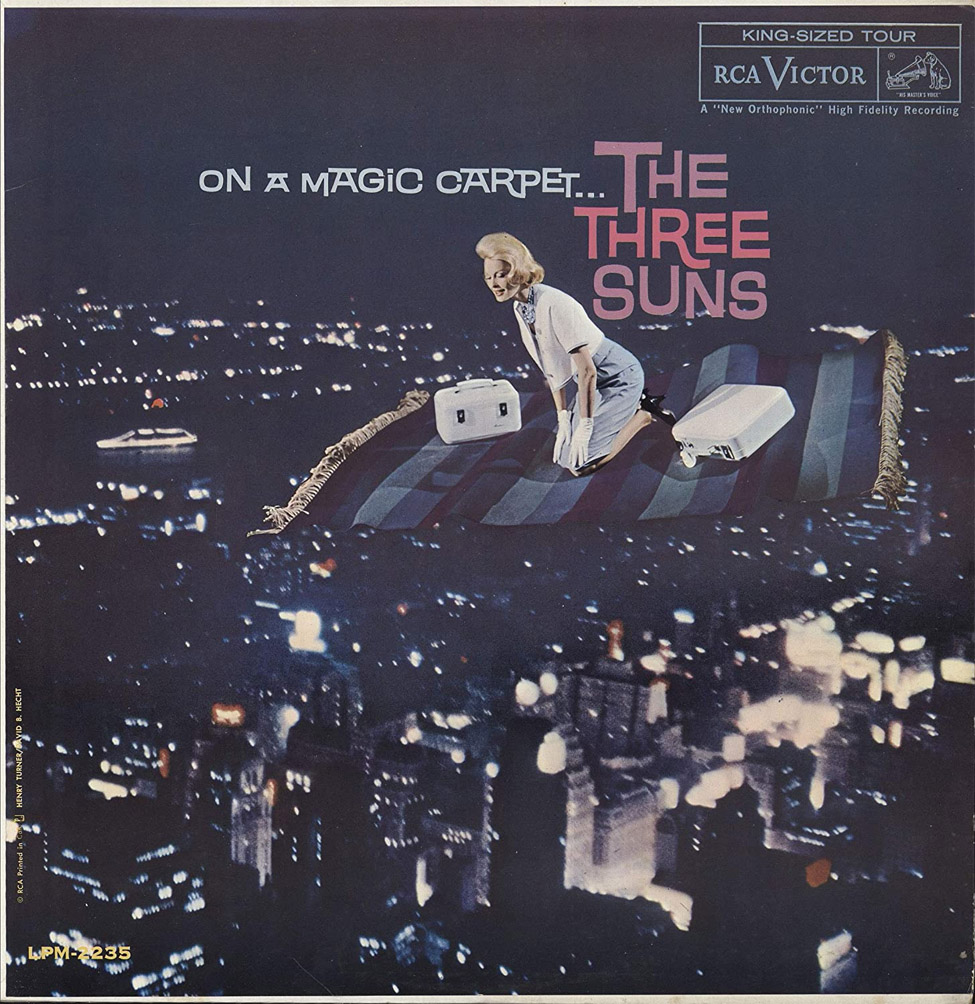
The Three Suns on
a Magic Carpet, Victor LPM-2235, 1960.
"...here's your
chance to fly now and be enchanted forever. You'll be travelling
first class all the way, on a magic carpet borne aloft by the artistry
of the inimitable Three Suns...On this trip time, space and
music are fused to perfection."
"Climb aboard this
album and you'll travel in spirit as well as in space -- no surprise
when you remember you're on a MAGIC CARPET."
Also noted on the back
cover: IMPORTANT NOTICE -- "MIRACLE SURFACE" This
record contains the new revolutionary anti-static ingredient 317X...
-- Text from back cover
of The Three Suns LP album).
Immortality
and the Phonograph's Promise to its Artists and the World.
Recorded voices were
seemingly immortal and it was a theme phonograph advertisements
would later promote. The Phonograph’s revolutionary ability to capture
ephemeral sound was also one of the earliest attributes newspapers
highlighted. The idea that the phonograph allowed the dead to speak
again was a wonder that defied nature.
Victor used the phrase
“Victor Supremacy”
for over a decade and it was primarily meant to convey its supremacy
of technology and of its recording artists. But it was also a claim
of Triumph over the ephemeral - Supremacy over mortality - Preservation
of culture for Posterity - “Art perpetuated for all time.”

"Jenny
Lind is only a memory, but the voice of Melba can never die."
Life Magazine, March 1918 (PM-2008).
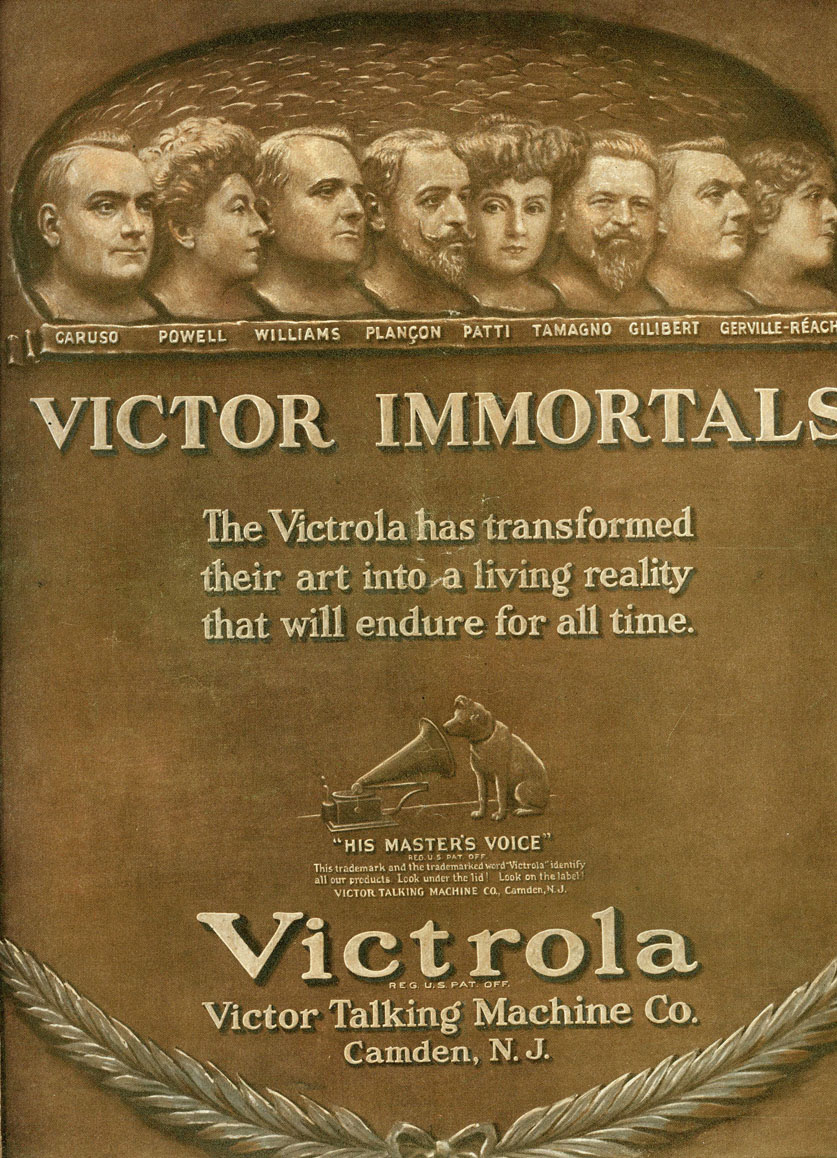
Victor artists who have passed are placed
on this memorial style plaque ad with the names and the word "Victor
Immortals - The Victrola has transformed their art into a living reality
that will endure for all time." 1922 (PM-2037).
In
the beginning it was a Wonder...and now?
In 1912 Chicago Tribune John
T. McCutcheon published a cartoon titled "Things
Don't Seem Wonderful If You've Seen Them All Your Life."
The cartoon "shows a young mother and father and their toddler
child. The parents are impressed with a racing automobile, a phonograph,
a wireless (radio) tower, an aeroplane, and a color moving picture
show, while the son is disinterested. In the last panel he is excited
and amazed at a goat cart."
The second panel is the phonograph
scene of amazement expressed by the parents while the young boy
plays with his dog.
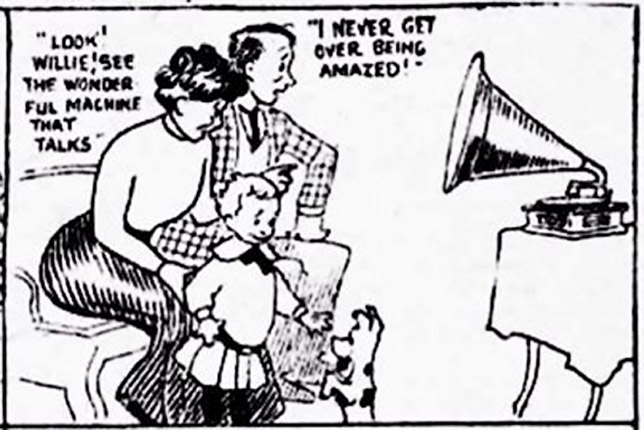
Panel from 1912 cartoon
by John T. McCutcheon.
It's a good reminder that wonders are
replaced by new wonders and new generations take for granted what
amazed a previous generation and often call early versions of those
wonders antiques.
For Friends of the Phonograph
recorded sound and the machines that first captured and played those
sounds will always be remembered.
The 1906 Victor brochure had it right:
"Many common things become wonders if we know how to look at
them, and many wonders become common things just because we do not
keep the wonder of them alive."
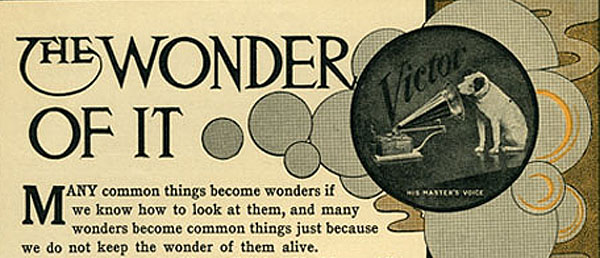
Accolades of Wonder: "Nineteenth
Century Wonder" - The Miracle of the 19th Century
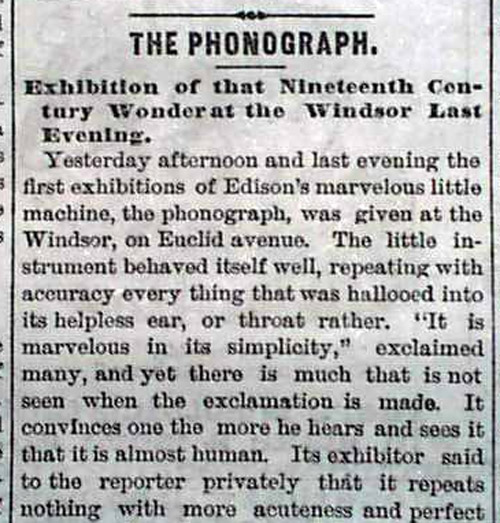
The "Nineteenth
Century Wonder," The Cleveland Leader, May 30, 1878.
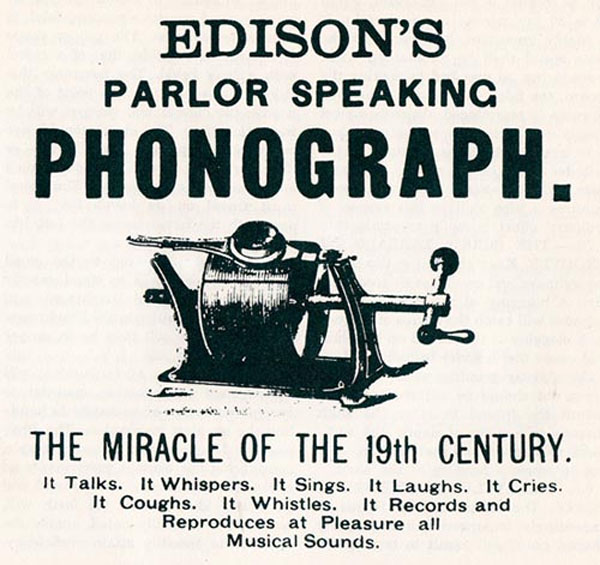
The Miracle of the 19th
Century
Top section of advertisement showing
Edison's Parlor Speaking Phonograph sold by The Edison Speaking Phonograph
Co., 1879 (Courtesy
Réne Rondeau).
POSTSCRIPT
Science, wonder, magic, miracle, invention,
genius, wizardry - All of those words related to Edison and his phonograph
-- a "talking wonder," "The Miracle of the 19th Century"
and the "dream of the inventor
realized." (1).
The total number of inventions and accomplishments
of Edison and his team over Edison's lifetime is more than simply
his number of patents. Likewise, the creation and iterations of all
human inventions from the beginning of time would be an interesting
number to know. But no matter how large that number the following
quote attributed to Edison discounts to practically zero what humanity
actually knows:
"We don't know a millionth
of one percent about anything." — Thomas Edison (as quoted
in Golden Book (April 1931), according to Stevenson's
Book of Quotations (Cassell 3rd edition 1938) by Burton Egbert
Stevenson - LibQuotes
also references Golden Book, April 1931, however, this quote
is not included in Stevenson's Book of Quotations 5th edition,
1946).
A cartoon titled "THE AGE OF SENSATION"
by F. Opper was published in PUCK, September 1889 and contained
humorous signage on the room's walls showing that an inventor who
is able to create sensational inventions requires the inventor to
be "a Wizard to Attract Attention."
"My Next Great Invention!!...;"
"Wait for my Flying Machine - None Others are Genuine;"
"Don't Disturb the Wizard! He is busy with Another Miracle.;"
and the caption for the panel itself: "Sensational Inventing
-- You Must Be a "Wizard" to Attract Attention."
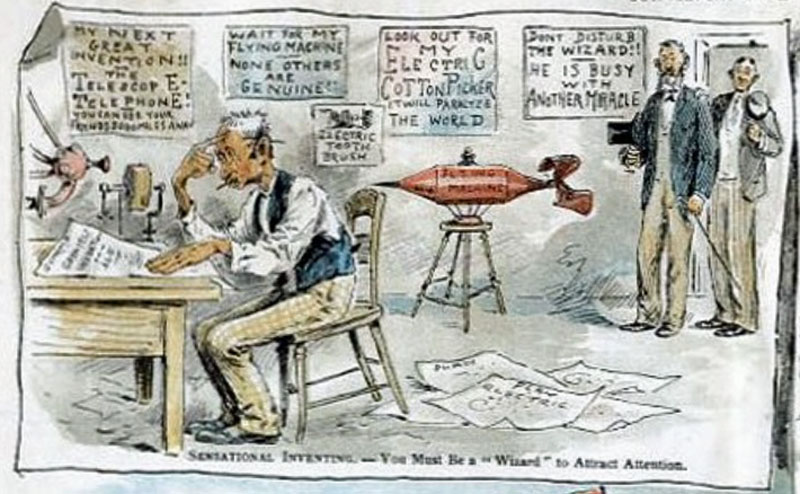
"You Must Be a "Wizard"
to Attract Attention."
"Sensational Inventing"
cartoon panel from "The
Age of Sensation" by F.Opper, Puck, September 1889.
This cartoon is surely
a humorous characterization of Edison, "the Wizard of Menlo Park."
Edison was known for seeking
and attracting the attention of the press with many newspaper articles
illustrating how he often promoted what he was going to invent next.
Compare the signage in the cartoon (my bolds) with some of Edison's
inventions which he had already created by 1889: "My Next
Great Invention!!" illustrated by improving the telephone
and also exemplified by his earlier quadruplex telegraph which
could remarkably send two messages simultaneously in each direction;
using a telescope and tasimeter
in Wyoming in 1878 to try to measure the energy levels of the
sun's corona during the solar eclipse; inventing an electric
pen, electric lightbulb and electricity infrastructures);
"his trade-marked face and signature being used as marketing
tools along with the phrase "Genuine", e.g, "None
Genuine without this signature" in ads to ensure attention
of the product was linked to its Edison lineage; "Another Miracle"
written on the cartoon's signage also could refer to his new improved
phonograph and "Perfected Phonograph" of 1889 which significantly
improved his original 1877 tinfoil Phonograph ("The Miracle of
the Nineteenth Century").
Nikola Tesla would be called
the Electrical Wizard so Edison wasn't the only "Wizard"
of his time. Nevertheless, Edison was the man whose phonograph captured
and replayed ephemeral sound; and Edison's lightbulb brought light
to homes at the flick of a switch, and those examples alone would
have been enough to give Edison a unique position in popular culture.
From 1979 to 1982 Sony's
tagline was Sony: The One and Only.
In 1889 it could have been
Edison: The One and Only.

Phonographia
|
